Paul van Yperen's Blog, page 344
June 1, 2016
Sybil Smolowa
Austrian-Czech actress and dancer Sybil Smolova (1900-?) was a star of the German and Swedish silent cinema of the 1910s and 1920s. She started as a dancer in Riga and Warsaw and the moved to Berlin. Her final film was the lesbian themed Anna und Elisabeth/Anna and Elisabeth (1933).
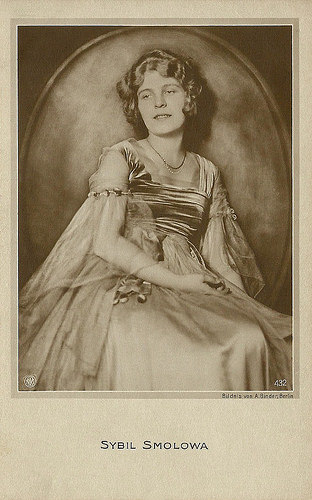
German postcard by NPG. no. 432. Photo: Alex Binder. Collection: Didier Hanson.
In Shame
Sybil Smolowa (or Sybill Smolowa, Sibyl Smolova and Sybil Smolova) was born in 1900 in Prague, then part of Austria-Hungary (Thomas Staedeli mentions Sweden as her birth country), but not much more is known about her private life. Her career began in the cities of Riga and Warsaw where she worked as a dancer.
In Warsaw, Smolowa appeared for the first time for the film camera at the Sphinx Film studio. Actor-director Friedrich Zelnik spotted her there and brought the young girl to Berlin to appear opposite him in the film Seelen, die sich nachts begegnen/Souls who meet at night (Eugen Illés, 1915), produced by the Danish studio Atlantik. Smolowa played a rich girl that gets 'in shame' (pregnant). Happily she meets a student (Zelnik) who takes care of her and learns her to love.
The following year, she appeared opposite Eduard von Winterstein in the drama Werner Krafft (Carl Froelich, 1916). Among her films were the Swedish drama I mörkrets bojor/In the Fetters of Darkness (Georg af Klercker, 1917), Im Schatten des Glücks/In the shadow of happiness (Robert Leffler, 1919) with Hans Adalbert Schlettow , and the two-partner Kinder der Finsternis/Children of Darkness (Ewald André Dupont, 1922) with Grit Hegesa and Hans Mierendorff.
Her final film was the lesbian themed drama Anna und Elisabeth/Anna and Elisabeth (Frank Wisbar, 1933) with Dorothea Wieck and Hertha Thiele . It would remain her only sound film. Sybil Smolowa retired from the film industry and disappeared from the public view.
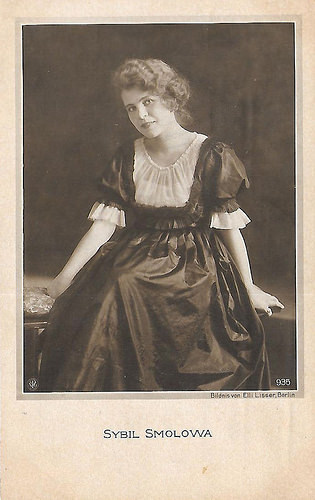
German postcard by NPG, no. 935. Photo: Elli Lisser, Berlin. Collection: Didier Hanson.
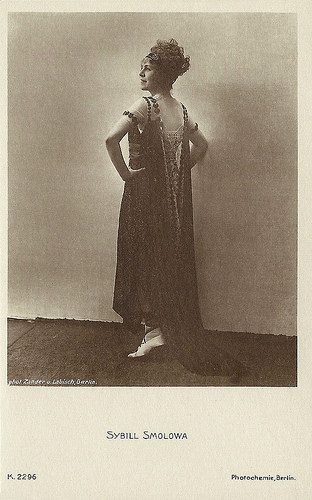
German postcard by Photochemie, Berlin, no. 2296. Photo: Zander & Labisch, Berlin. Collection: Didier Hanson.
Sources: Thomas Staedeli (Cyranos), Wikipedia (German) and .

German postcard by NPG. no. 432. Photo: Alex Binder. Collection: Didier Hanson.
In Shame
Sybil Smolowa (or Sybill Smolowa, Sibyl Smolova and Sybil Smolova) was born in 1900 in Prague, then part of Austria-Hungary (Thomas Staedeli mentions Sweden as her birth country), but not much more is known about her private life. Her career began in the cities of Riga and Warsaw where she worked as a dancer.
In Warsaw, Smolowa appeared for the first time for the film camera at the Sphinx Film studio. Actor-director Friedrich Zelnik spotted her there and brought the young girl to Berlin to appear opposite him in the film Seelen, die sich nachts begegnen/Souls who meet at night (Eugen Illés, 1915), produced by the Danish studio Atlantik. Smolowa played a rich girl that gets 'in shame' (pregnant). Happily she meets a student (Zelnik) who takes care of her and learns her to love.
The following year, she appeared opposite Eduard von Winterstein in the drama Werner Krafft (Carl Froelich, 1916). Among her films were the Swedish drama I mörkrets bojor/In the Fetters of Darkness (Georg af Klercker, 1917), Im Schatten des Glücks/In the shadow of happiness (Robert Leffler, 1919) with Hans Adalbert Schlettow , and the two-partner Kinder der Finsternis/Children of Darkness (Ewald André Dupont, 1922) with Grit Hegesa and Hans Mierendorff.
Her final film was the lesbian themed drama Anna und Elisabeth/Anna and Elisabeth (Frank Wisbar, 1933) with Dorothea Wieck and Hertha Thiele . It would remain her only sound film. Sybil Smolowa retired from the film industry and disappeared from the public view.

German postcard by NPG, no. 935. Photo: Elli Lisser, Berlin. Collection: Didier Hanson.

German postcard by Photochemie, Berlin, no. 2296. Photo: Zander & Labisch, Berlin. Collection: Didier Hanson.
Sources: Thomas Staedeli (Cyranos), Wikipedia (German) and .
Published on June 01, 2016 22:00
May 31, 2016
Das Geschlecht derer von Ringwall (1918)
Henny Porten (1890-1960) was one of the three most famous divas of the early German silent cinema. She produced many of her own films, but started her career at film pioneer Oskar Messter's studio Messter-Film. A fine example is the drama Das Geschlecht derer von Ringwall/The Dynasty of von Ringwall (Rudolf Biebrach, 1918) in which she co-starred with German actor Bruno Decarli.
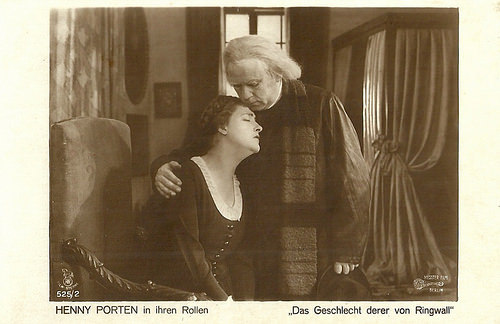
German postcard by Rotophot in the Film Sterne series, no. 525/2. Photo: Messter-Film, Berlin. Publicity still for Das Geschlecht derer von Ringwall (Rudolf Biebrach, 1918) with Henny Porten .
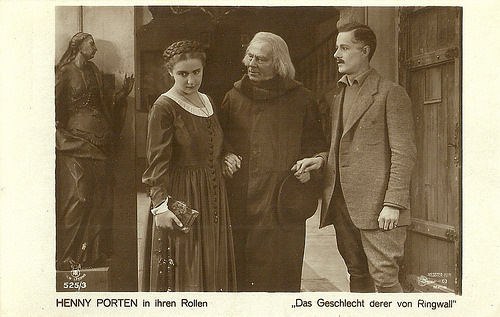
German postcard by Rotophot in the Film Sterne series, no. 525/3. Photo: Messter-Film, Berlin. Publicity still for Das Geschlecht derer von Ringwall (Rudolf Biebrach, 1918) with Henny Porten and Heinz Burkart (right).
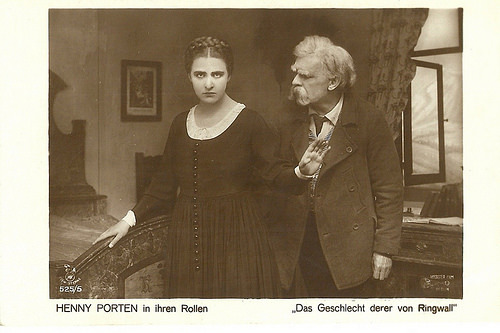
German postcard by Rotophot in the Film Sterne series, no. 525/5. Photo: Messter-Film, Berlin. Publicity still for Das Geschlecht derer von Ringwall (Rudolf Biebrach, 1918) with Henny Porten and Rudolf Biebrach.
Love is Bigger than Revenge
Das Geschlecht derer von Ringwall/The Dynasty of von Ringwall (Rudolf Biebrach, 1918) narrates of Magdalena von Ringwall ( Henny Porten ) and her brother Arpad ( Kurt Vespermann ), who are the last descendants of the Ringwall family.
Arpad is murdered but the culprit cannot be found. Magdalena meets a man, Vormund ( Bruno Decarli ), and falls in love with him, unknowing that he his Arpad's murderer. When she is finally informed, her love is bigger than her call for revenge.
Das Geschlecht derer von Ringwall was produced by Messter (Film)Projektion in Berlin in a series called, Seltsame Menschen (Strange people).
The crew for the film is interesting. Robert Wiene, the director of the classic wrote the script. Cameraman was Karl Freund and the sets were designed by Jack Winter and Ludwig Kainer. Supporting actors in the cast were Frida Richard, Heinz Burkart and director Rudolf Biebrach.
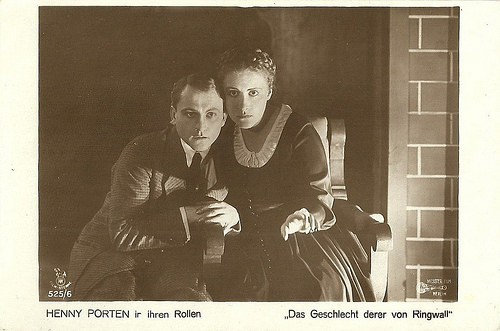
German postcard by Rotophot in the Film Sterne series, no. 525/6. Photo: Messter-Film, Berlin. Publicity still for Das Geschlecht derer von Ringwall (Rudolf Biebrach, 1918) with Kurt Vespermann and Henny Porten .
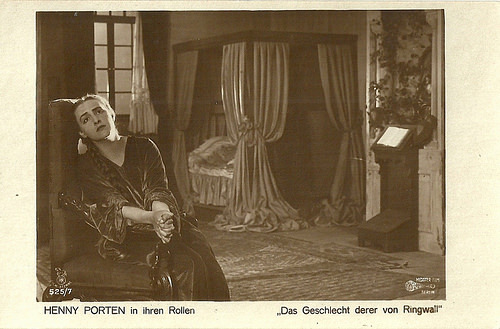
German postcard by Rotophot in the Film Sterne series, no. 525/7. Photo: Messter-Film, Berlin. Publicity still for Das Geschlecht derer von Ringwall (Rudolf Biebrach, 1918).
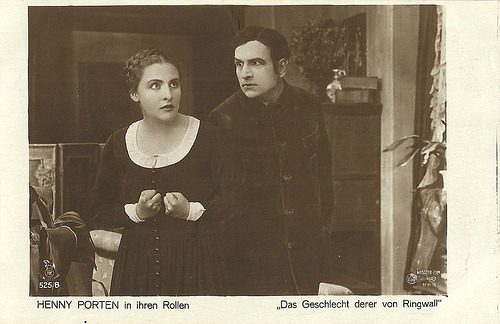
German postcard by Rotophot in the Film Sterne series, no. 525/8. Photo: Messter-Film, Berlin. Publicity still for Das Geschlecht derer von Ringwall (Rudolf Biebrach, 1918) with Henny Porten and Bruno Decarli .
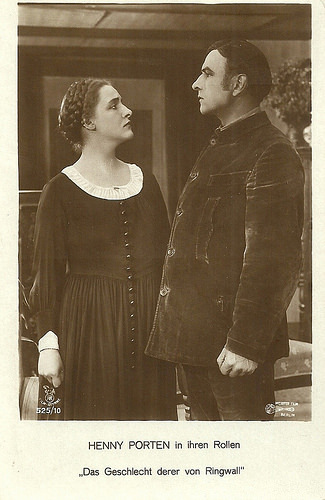
German postcard by Rotophot in the Film Sterne series, no. 525/10. Photo: Messter-Film, Berlin. Publicity still for Das Geschlecht derer von Ringwall (Rudolf Biebrach, 1918) with Henny Porten and Bruno Decarli .
Source: Wikipedia (German), The German Early Cinema Database, Filmportal.de and IMDb.

German postcard by Rotophot in the Film Sterne series, no. 525/2. Photo: Messter-Film, Berlin. Publicity still for Das Geschlecht derer von Ringwall (Rudolf Biebrach, 1918) with Henny Porten .

German postcard by Rotophot in the Film Sterne series, no. 525/3. Photo: Messter-Film, Berlin. Publicity still for Das Geschlecht derer von Ringwall (Rudolf Biebrach, 1918) with Henny Porten and Heinz Burkart (right).

German postcard by Rotophot in the Film Sterne series, no. 525/5. Photo: Messter-Film, Berlin. Publicity still for Das Geschlecht derer von Ringwall (Rudolf Biebrach, 1918) with Henny Porten and Rudolf Biebrach.
Love is Bigger than Revenge
Das Geschlecht derer von Ringwall/The Dynasty of von Ringwall (Rudolf Biebrach, 1918) narrates of Magdalena von Ringwall ( Henny Porten ) and her brother Arpad ( Kurt Vespermann ), who are the last descendants of the Ringwall family.
Arpad is murdered but the culprit cannot be found. Magdalena meets a man, Vormund ( Bruno Decarli ), and falls in love with him, unknowing that he his Arpad's murderer. When she is finally informed, her love is bigger than her call for revenge.
Das Geschlecht derer von Ringwall was produced by Messter (Film)Projektion in Berlin in a series called, Seltsame Menschen (Strange people).
The crew for the film is interesting. Robert Wiene, the director of the classic wrote the script. Cameraman was Karl Freund and the sets were designed by Jack Winter and Ludwig Kainer. Supporting actors in the cast were Frida Richard, Heinz Burkart and director Rudolf Biebrach.

German postcard by Rotophot in the Film Sterne series, no. 525/6. Photo: Messter-Film, Berlin. Publicity still for Das Geschlecht derer von Ringwall (Rudolf Biebrach, 1918) with Kurt Vespermann and Henny Porten .

German postcard by Rotophot in the Film Sterne series, no. 525/7. Photo: Messter-Film, Berlin. Publicity still for Das Geschlecht derer von Ringwall (Rudolf Biebrach, 1918).

German postcard by Rotophot in the Film Sterne series, no. 525/8. Photo: Messter-Film, Berlin. Publicity still for Das Geschlecht derer von Ringwall (Rudolf Biebrach, 1918) with Henny Porten and Bruno Decarli .

German postcard by Rotophot in the Film Sterne series, no. 525/10. Photo: Messter-Film, Berlin. Publicity still for Das Geschlecht derer von Ringwall (Rudolf Biebrach, 1918) with Henny Porten and Bruno Decarli .
Source: Wikipedia (German), The German Early Cinema Database, Filmportal.de and IMDb.
Published on May 31, 2016 22:00
May 30, 2016
Hannelore Elsner
Grand German actress Hannelore Elsner (1942) started her film career in quickly forgotten light entertainment film, but in later years, she starred in films by interesting directors like Edgar Reitz, István Szabó, Dani Levy and Uli Edel. She is best known for her roles in popular TV series such as Die Schwarzwaldklinik/The Black Forest Hospital (1987-1988) and the detective series Die Kommissarin/The Inspectoress (1994-2006).
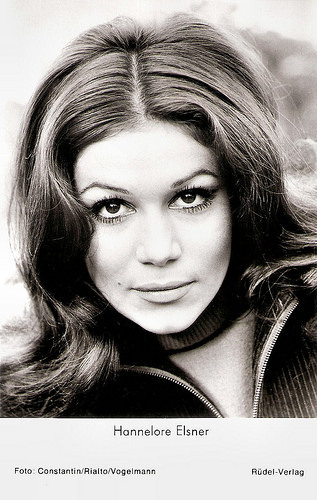
German postcard by Franz Josef Rüdel, Filmpostkartenverlag, Hamburg. Photo: Constantin / Rialto / Vogelmann. Publicity still for Zum Teufel mit der Penne - Die Lümmel von der ersten Bank, 2. Teil/To hell with the pen - The clown of the first bank, Part 2 (Werner Jacobs, 1968).
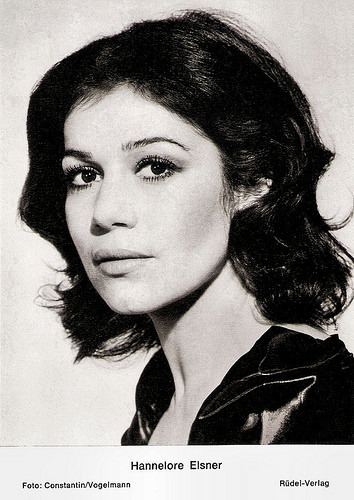
German postcard by Franz Josef Rüdel, Filmpostkartenverlag, Hamburg. Photo: Constantin / Vogelmann. Publicity still for ...aber Jonny!/...But Johnny! (Alfred Weidenmann, 1973).
Heimat
Hannelore Elsner was born Hannelore Elstner in 1942 in Burghausen, Bavaria. Her father, an engineer, died when she was eight years old. She lost her brother, who was three years older, during a World War II air raid.
In 1959, she made her screen debut in the Heimatfilm Alt Heidelberg/Old Heidelberg (Ernst Marischka, 1959) starring Christian Wolff . That year she also played small parts in Immer die Mädchen/Always the girls (Fritz Rémond Jr., 1959), with Hans-Joachim Kulenkampff, and Freddy unter fremden Sternen/Freddy under foreign stars (Wolfgang Schleif, 1959), featuring Schlager singer Freddy Quinn.
She had her first starring role in Das Mädchen mit den schmalen Hüften/Yusha (Johannes Kai, 1961) opposite Claus Wilcke . After finishing drama school in her hometown Burghausen in 1962, she worked in theatres in Berlin and München.
During the 1960s she continued to play in several light entertainment films, including the comedy Zur Hölle mit den Paukern/To hell with the drummers (Werner Jacobs, 1968). It was the first entry into the seven part Die Lümmel von der ersten Bank/The clown of the first bank series of comedy films starring Hansi Kraus and Theo Lingen . Elsner also appeared in the sports comedy Willi wird das Kind schon schaukeln/Willi Manages The Whole Thing (Werner Jacobs, 1972). It was the final entry into a four film series with Heinz Erhardt as Willi.
She also played in more serious films like Die Reise nach Wien/Trip to Vienna (Edgar Reitz, 1973), in which she co-starred with Elke Sommer and Mario Adorf . During the closing months of the Second World War, two small-town German women discover some money in an attic and decide to spend it on a trip to Vienna. Interesting was also the Italian adventure film Il ritorno di Zanna Bianca/Challenge to White Fang (Lucio Fulci, 1974) starring Franco Nero . It is the only official sequel to the box office hit Zanna Bianca/White Fang (Lucio Fulci, 1973).
From then on, she appeared in arthouse films like Berlinger (Alf Brustellin, Bernhard Sinkel, 1975), featuring Martin Benrath, the comedy Bomber & Paganini (Nicos Perakis, 1976) with Mario Adorf , and Grete Minde (Heidi Genée, 1977), based on the novel by Theodor Fontane and featuring Katerina Jacob.
For Der Schneider von Ulm/The Tailor from Ulm (1979), she reunited with director Edgar Reitz, who became famous for his TV series Heimat, in which Elsner also had a role. Der Schneider von Ulm tells the true story of a German pioneer aviator, Albrecht Berblinger (Tilo Prückner), in the late 18th century.
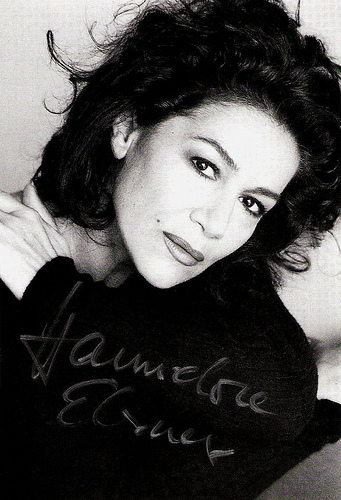
German autograph card. Photo: Ruth Kappus.
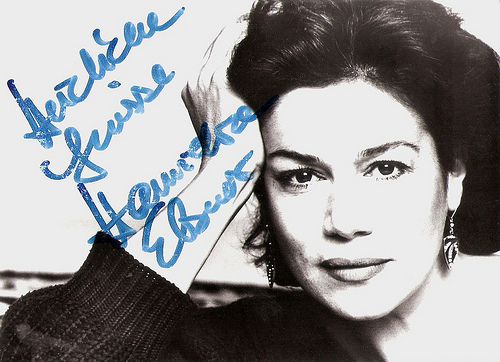
German postcard by Franz Josef Rüdel, Hamburg. Photo: Karin Rocholl, Hamburg.
First Krimi with a Female Lead
During the 1980s and 1990s, Hannelore Elsner starred in several films but also in many popular TV series such as Die Schwarzwaldklinik/The Black Forest Hospital (1987-1988). In 1980, she starred in the cold-war melodrama Der grüne Vogel/The green bird (1980) by acclaimed director István Szabó.
Her other films included the Swiss drama Mann ohne Gedächtnis/Man Without Memory (Kurt Gloor, 1984), the drama Marie Ward - Zwischen Galgen und Glorie/Marie Ward: Between gallows and glory (Angelika Weber, 1985), and the British crime film Parker (Jim Goddard, 1985) starring Bryan Brown.
She became well known in Germany and other German speaking countries for her role in the German detective series Die Kommissarin/The Inspectoress (1994-2006). The series, which takes place in Frankfurt am Main, Germany, is notable as being the first, and as one of the most successful, Krimi series with a female lead character. She played the lead character Inspector Lea Sommer in 66 episodes. Sommer is divorced with custody of her teenage son, Daniel. She is looking forward to a new relationship with her new boyfriend, Jonathan. Although Lea and Jonathan telephone each other frequently, he is never seen or heard on screen. Sommer was originally paired with Nick Siegel ( Til Schweiger ), but in a 1996 episode, Siegel was shot to death by an escaping criminal.
Elsner’s later films include Die Unberührbare/No Place to Go (Oskar Roehler, 2000) with Vadim Glowna, and Alles auf Zucker!/Go for Zucker (Dani Levy, 2004). This ironic comedy about modern Jewish identity in present-day Germany can be seen as part of the ´Ossi-Wessi´ confrontation within Germany. Henry Hübchen stars as Jaecki Zucker, and Elsner co-stars as his mother.
She then co-starred in the drama Kirschblüten – Hanami/Cherry Blossoms (Doris Dörrie, 2008), which tells the story of Rudi (Elmar Wepper): terminally ill, he travels to Japan after the sudden death of his wife Trudi (Elsner) – in order to make up for missed opportunities in life. Elsner also played German rapper Bushido’s mother in the biographical film Zeiten ändern dich/Times change you (Uli Edel, 2008), starring Bushido himself. Recently, she appeared in Hin und weg/Tour de Force (Christian Zübert, 2014), a powerful drama about euthanasia starring Florian David Fitz, and Hannas schlafende Hunde/Hanna’s sleeping dogs (Andreas Gruber, 2016).
Hannelore Elsner’s longtime companion is Professor Günter Blamberger. She was previously married to actor Gerd Vespermann (1964-1966) and Uwe Carstensen (1993-2000). She has a son, Dominik (1981), from a relationship with director Dieter Wedel.
Trailer Die endlose Nacht - Nebel über Tempelhof (1963). Source: Arild Rafalzik (YouTube).
Trailer for Il ritorno di Zanna Bianca/Challenge to White Fang (1974). Source: Italo-Cinema Trailer (YouTube).
German trailer for Auf das Leben/To Life! (2014). Source: Berlin & Beyond Film Festival (YouTube).
German trailer for Hannas schlafende Hunde/Hanna’s sleeping dogs (2016). Source: Vipmagazin (YouTube).
Sources: Wikipedia, and b.

German postcard by Franz Josef Rüdel, Filmpostkartenverlag, Hamburg. Photo: Constantin / Rialto / Vogelmann. Publicity still for Zum Teufel mit der Penne - Die Lümmel von der ersten Bank, 2. Teil/To hell with the pen - The clown of the first bank, Part 2 (Werner Jacobs, 1968).

German postcard by Franz Josef Rüdel, Filmpostkartenverlag, Hamburg. Photo: Constantin / Vogelmann. Publicity still for ...aber Jonny!/...But Johnny! (Alfred Weidenmann, 1973).
Heimat
Hannelore Elsner was born Hannelore Elstner in 1942 in Burghausen, Bavaria. Her father, an engineer, died when she was eight years old. She lost her brother, who was three years older, during a World War II air raid.
In 1959, she made her screen debut in the Heimatfilm Alt Heidelberg/Old Heidelberg (Ernst Marischka, 1959) starring Christian Wolff . That year she also played small parts in Immer die Mädchen/Always the girls (Fritz Rémond Jr., 1959), with Hans-Joachim Kulenkampff, and Freddy unter fremden Sternen/Freddy under foreign stars (Wolfgang Schleif, 1959), featuring Schlager singer Freddy Quinn.
She had her first starring role in Das Mädchen mit den schmalen Hüften/Yusha (Johannes Kai, 1961) opposite Claus Wilcke . After finishing drama school in her hometown Burghausen in 1962, she worked in theatres in Berlin and München.
During the 1960s she continued to play in several light entertainment films, including the comedy Zur Hölle mit den Paukern/To hell with the drummers (Werner Jacobs, 1968). It was the first entry into the seven part Die Lümmel von der ersten Bank/The clown of the first bank series of comedy films starring Hansi Kraus and Theo Lingen . Elsner also appeared in the sports comedy Willi wird das Kind schon schaukeln/Willi Manages The Whole Thing (Werner Jacobs, 1972). It was the final entry into a four film series with Heinz Erhardt as Willi.
She also played in more serious films like Die Reise nach Wien/Trip to Vienna (Edgar Reitz, 1973), in which she co-starred with Elke Sommer and Mario Adorf . During the closing months of the Second World War, two small-town German women discover some money in an attic and decide to spend it on a trip to Vienna. Interesting was also the Italian adventure film Il ritorno di Zanna Bianca/Challenge to White Fang (Lucio Fulci, 1974) starring Franco Nero . It is the only official sequel to the box office hit Zanna Bianca/White Fang (Lucio Fulci, 1973).
From then on, she appeared in arthouse films like Berlinger (Alf Brustellin, Bernhard Sinkel, 1975), featuring Martin Benrath, the comedy Bomber & Paganini (Nicos Perakis, 1976) with Mario Adorf , and Grete Minde (Heidi Genée, 1977), based on the novel by Theodor Fontane and featuring Katerina Jacob.
For Der Schneider von Ulm/The Tailor from Ulm (1979), she reunited with director Edgar Reitz, who became famous for his TV series Heimat, in which Elsner also had a role. Der Schneider von Ulm tells the true story of a German pioneer aviator, Albrecht Berblinger (Tilo Prückner), in the late 18th century.

German autograph card. Photo: Ruth Kappus.

German postcard by Franz Josef Rüdel, Hamburg. Photo: Karin Rocholl, Hamburg.
First Krimi with a Female Lead
During the 1980s and 1990s, Hannelore Elsner starred in several films but also in many popular TV series such as Die Schwarzwaldklinik/The Black Forest Hospital (1987-1988). In 1980, she starred in the cold-war melodrama Der grüne Vogel/The green bird (1980) by acclaimed director István Szabó.
Her other films included the Swiss drama Mann ohne Gedächtnis/Man Without Memory (Kurt Gloor, 1984), the drama Marie Ward - Zwischen Galgen und Glorie/Marie Ward: Between gallows and glory (Angelika Weber, 1985), and the British crime film Parker (Jim Goddard, 1985) starring Bryan Brown.
She became well known in Germany and other German speaking countries for her role in the German detective series Die Kommissarin/The Inspectoress (1994-2006). The series, which takes place in Frankfurt am Main, Germany, is notable as being the first, and as one of the most successful, Krimi series with a female lead character. She played the lead character Inspector Lea Sommer in 66 episodes. Sommer is divorced with custody of her teenage son, Daniel. She is looking forward to a new relationship with her new boyfriend, Jonathan. Although Lea and Jonathan telephone each other frequently, he is never seen or heard on screen. Sommer was originally paired with Nick Siegel ( Til Schweiger ), but in a 1996 episode, Siegel was shot to death by an escaping criminal.
Elsner’s later films include Die Unberührbare/No Place to Go (Oskar Roehler, 2000) with Vadim Glowna, and Alles auf Zucker!/Go for Zucker (Dani Levy, 2004). This ironic comedy about modern Jewish identity in present-day Germany can be seen as part of the ´Ossi-Wessi´ confrontation within Germany. Henry Hübchen stars as Jaecki Zucker, and Elsner co-stars as his mother.
She then co-starred in the drama Kirschblüten – Hanami/Cherry Blossoms (Doris Dörrie, 2008), which tells the story of Rudi (Elmar Wepper): terminally ill, he travels to Japan after the sudden death of his wife Trudi (Elsner) – in order to make up for missed opportunities in life. Elsner also played German rapper Bushido’s mother in the biographical film Zeiten ändern dich/Times change you (Uli Edel, 2008), starring Bushido himself. Recently, she appeared in Hin und weg/Tour de Force (Christian Zübert, 2014), a powerful drama about euthanasia starring Florian David Fitz, and Hannas schlafende Hunde/Hanna’s sleeping dogs (Andreas Gruber, 2016).
Hannelore Elsner’s longtime companion is Professor Günter Blamberger. She was previously married to actor Gerd Vespermann (1964-1966) and Uwe Carstensen (1993-2000). She has a son, Dominik (1981), from a relationship with director Dieter Wedel.
Trailer Die endlose Nacht - Nebel über Tempelhof (1963). Source: Arild Rafalzik (YouTube).
Trailer for Il ritorno di Zanna Bianca/Challenge to White Fang (1974). Source: Italo-Cinema Trailer (YouTube).
German trailer for Auf das Leben/To Life! (2014). Source: Berlin & Beyond Film Festival (YouTube).
German trailer for Hannas schlafende Hunde/Hanna’s sleeping dogs (2016). Source: Vipmagazin (YouTube).
Sources: Wikipedia, and b.
Published on May 30, 2016 22:00
May 29, 2016
Stewart Rome
Stewart Rome (1886-1965) was a British actor of the silent screen. In the 1910s he was often paired with Alma Taylor and Chrissie White. In 1915 he was voted second only to Chaplin in a Pictures magazine popularity poll. In a big court case he was granted the rights to his stage name after being sued by his former producer Cecil M. Hepworth in 1919.
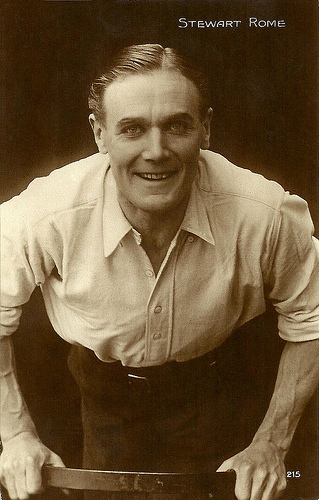
French postcard by Cinémagazine, no. 215.
Hepworth
Stewart Rome was born in Newbury, England in 1886. His birthname was Wernham Ryott Gifford according to Wikipedia , while Sandra Brennan at AllMovie and the IMDb list him as Septimus Wernham Ryott. Wernham Ryott was the name under which he wrote the script of The Man From India (1914).
Ryott studied to be a civil engineer, but instead went on the stage. After performing in Australia, he returned to the UK in 1912 and joined the Hepworth company in 1913. Hepworth renamed him Stewart Rome, and when he left Hepworth, after WW1 service, to join Broadwest he was forced to sue to keep the name.
At Hepworth, Rome played in dramas, crime films and comedies that were often directed by Frank Wilson, but also by Warwick Buckland or by producer Cecil Hepworth himself. From 1914 on, Rome often starred opposite Alma Taylor , Chrissie White and Violet Hopson , three female Hepworth regulars by then, while Lionelle Howard was often his male co-actor. Rome mostly had the male lead himself.
In the year 1914 Rome was already highly active, playing in some 30 short and medium-length films, such as the Charles Dickens adaptation The Chimes (Thomas Bentley, 1914), with Hopson and Warwick Buckland co-acting. In 1915 he repeated this amazing productivity with some 28 films. In addition to many short films, Rome also did several features like The Baby on the Barge (Cecil Hepworth, 1915), The Incorruptible Crown (Frank Wilson, 1915), Sweet Lavender (Cecil Hepworth, 1915), As the Sun Went Down (Frank Wilson, 1915), Barnaby Rudge (Thomas Bentley, Cecil Hepworth, 1915), and The Bottle (Cecil Hepworth, 1915).
He wrote the scripts for the films The Shepherd of Souls (Frank Wilson, 1915) and Coward! (Frank Wilson, 1915) in which he also impersonated a role. As Rome did less and less shorts, the number of his films decreased in the following years, but still he managed to play in 12 films in 1916. Among these films are Trelawny of the Wells (1916), Iris (1916), Annie Laurie (1916), and Coming Thro’ the Rye (1916), all directed by Cecil Hepworth and costarring Alma Taylor .
In 1917 Rome’s performances slowed down to 6 films. He made The Cobweb (Cecil Hepworth, 1917) and The American Heiress (Cecil Hepworth, 1917) with Alma Taylor , but he also appeared in films with Chrissie White as the female lead, such as The Eternal Triangle (Frank Wilson, 1917). In 1918 Stewart Rome only did only two films for Hepworth, probably because of the law case between Hepworth and Rome.
In 1919 he started to play with Violet Hopson in a string of dramas for his new studio. The first was probably the sports drama The Gentleman Rider (Walter West, 1919), which was followed by Snow in the Desert, A Great Coup, A Daughter of Eve, The Romance of a Movie Star, The Case of Lady Camber, Her Son, The Imperfect Lover, and When Greek Meets Greek. These films were almost all directed by Walter West for the company Broadwest and later for Walter West Productions, and almost all co-starring Violet Hopson . Incidentally Rome worked with other directors, such as Einar Bruun, or other co-leads such as Fabienne Fabrèges.
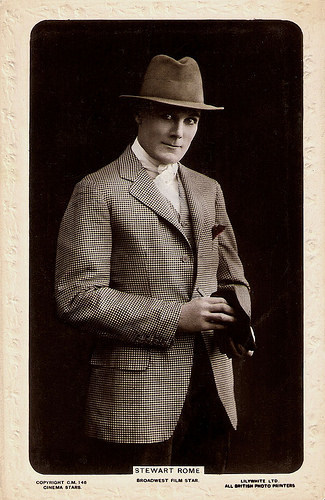
British postcard in the Lilywhite Photographic Series, no. C.M. 146. Photo: Broadwest.
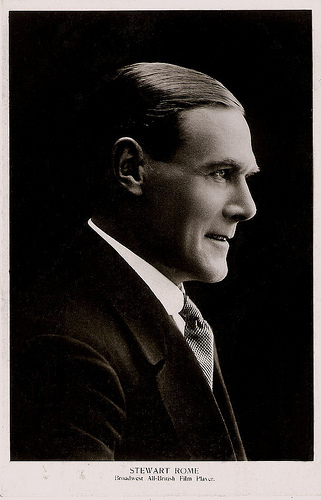
British postcard. Photo: Broadwest.
Detective William Voss
In the Encyclopedia of British Film , Anthony Slide characterises Stewart Rome as 'A slightly aloof and aristocratic-looking leading man'. In 1923 Rome went to work more international. He played in The Prodigal Son (A.E. Coleby, 1923), which was shot in Iceland and was based on a novel by Hall Caine.
In the same year he played Desmarets in the French Honoré de Balzac adaptation Ferragus (Gaston Ravel, 1923), opposite René Navarre in the title role. And he performed in the British-German coproduction Im Schatten der Moschee/In the Shadow of the Mosque (Walter R. Hall, 1923), produced by John Hagenbeck-Film.
In 1924 he was reunited with West and Hopson in the sports drama The Stirrup Cup Sensation (Walter West, 1924), he played opposite Mary Odette in Nets of Destiny (Arthur Rooke, 1924), opposite Betty Balfour in Réveille (George Pearson, 1924), and opposite Fay Compton and Lillian Hall-Davis in The Eleventh Commandment (George A. Cooper, 1924). Anthony Slide writes in the Encyclopedia of British Film : "He is memorable as the shell-shocked veteran in George Pearson's Reveille (1924), but is obviously too old to remain an acceptable leading man."
In 1925-1927 Rome went international again, playing detective William Voss in the Anglo-German co-production Vater Voss/Father Voss (Max Mack, 1925). After one film in Britain with Marjorie Hume : Thou Fool (Fred Paul, 1926), Rome tried his luck in Hollywood, playing in one American film: The Silver Treasure (Rowland V. Lee, 1926) starring George O’Brien.
Rome didn’t stay long in Hollywood. In 1927 he was back in Europe, in Berlin, to perform in three Elga Brink vehicles Die Frau ohne Nahmen/The Nameless Woman (1927), Liebe im Rausch/Intoxicated Love (1927), and Die Jagd nach der Braut/Bride Chase (1926), all directed by Georg Jacoby.
In the late 1920s Rome continued to play the male leads in several British films, in particular thrillers based on Edgar Wallace such as The Man Who Changed His Name (A.V. Bramble, 1928) or on Agatha Christie such as The Passing of Mr. Quin (Julius Hagen, Leslie S. Hiscott, 1928).
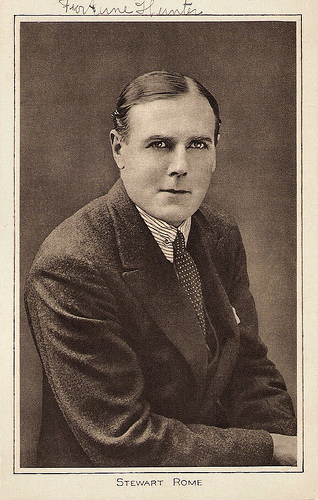
British postcard in the Pictures' Portrait Gallery by Pictures Ltd., London, no. 59. Photo: Broadwest Films Ltd.
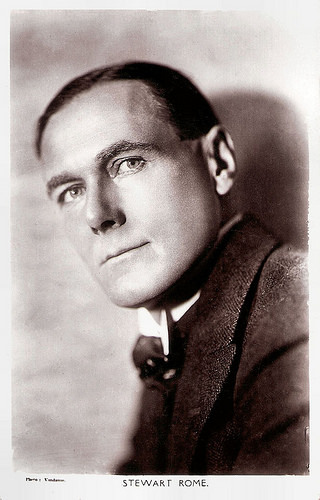
British postcard in the Picturegoer Series, London, no. 53. Photo: Vandamm.
Dr. Goodfellow
Stewart Rome smoothly made the passage from silent to sound. Already in 1929 he played the lead in Dark Red Roses (Sinclair Hill, 1929), made for British Sound Film productions.
In the same year he played in the German production Der rote Kreis/The Red Circle (1929), which director Friedrich Zelnik first released as a silent film, but later had sound dubbed in using the British De Forest Phonofilm sound-on-film system – the Germans weren’t that far yet with sound cinema. It starred Zelnik’s wife and star Lya Mara , but also other renowned German and Austrian actors like Fred Louis Lerch , Hans Albers and Otto Wallburg . The film was again based on an Edgar Wallace story.
Rome also played in an Austrian-German film: Hingabe/The Woman at the Cross (Guido Brignone, 1929), which was still shot and released as a silent film. It starred Marcella Albani .
Until the late 1930s Stewart Rome continued to play in some 20 to 25 films, as a kindly character actor. These films ranged from crime films like Deadlock (Maurice Elvey, 1931) and Rynox (Michael Powell, 1932) to light musical comedies like Temptation (Max Neufeld, 1934), and from sports dramas like Kissing Cup's Race (Castleton Knight, 1930) to war dramas like Lest We Forget (John Baxter, 1934). Instead of Alma Taylor and Violet Hopson, his leading ladies were now Madeleine Carroll and Frances Day.
Towards the war years, Rome’s roles became smaller. He continued to play small parts in British cinema until 1950. In 1942, Rome began appearing for Rank as Dr Goodfellow in a series of inspirational shorts, 'A Sunday Thought for the Coming Week', roundly jeered at by audiences. His final role was a supporting part in the crime comedy Let's Have a Murder (John E. Blakeley, 1950).
In 1965 Stewart Rome died in his birthplace Newbury in England, at age 79. He was married to Grace Miller.
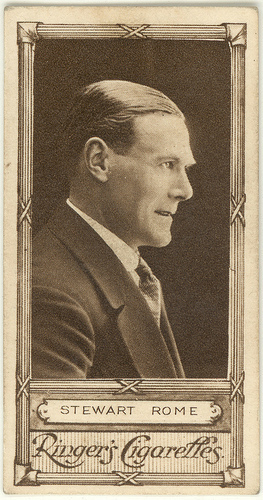
British cigarette card by Ringer's Cigarettes. Collection: Rescued by Rover (Flickr).
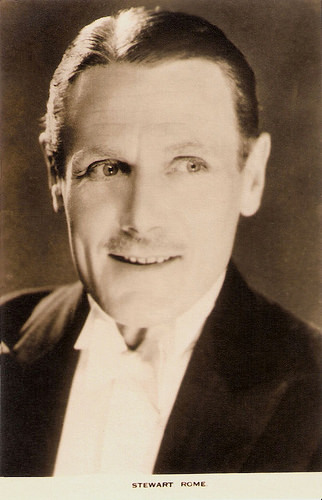
British postcard.
Sources: Anthony Slide (Encyclopedia of British Film), Thomas Staedeli (Cyranos), Sandra Brennan (AllMovie), BFI, Wikipedia, and .

French postcard by Cinémagazine, no. 215.
Hepworth
Stewart Rome was born in Newbury, England in 1886. His birthname was Wernham Ryott Gifford according to Wikipedia , while Sandra Brennan at AllMovie and the IMDb list him as Septimus Wernham Ryott. Wernham Ryott was the name under which he wrote the script of The Man From India (1914).
Ryott studied to be a civil engineer, but instead went on the stage. After performing in Australia, he returned to the UK in 1912 and joined the Hepworth company in 1913. Hepworth renamed him Stewart Rome, and when he left Hepworth, after WW1 service, to join Broadwest he was forced to sue to keep the name.
At Hepworth, Rome played in dramas, crime films and comedies that were often directed by Frank Wilson, but also by Warwick Buckland or by producer Cecil Hepworth himself. From 1914 on, Rome often starred opposite Alma Taylor , Chrissie White and Violet Hopson , three female Hepworth regulars by then, while Lionelle Howard was often his male co-actor. Rome mostly had the male lead himself.
In the year 1914 Rome was already highly active, playing in some 30 short and medium-length films, such as the Charles Dickens adaptation The Chimes (Thomas Bentley, 1914), with Hopson and Warwick Buckland co-acting. In 1915 he repeated this amazing productivity with some 28 films. In addition to many short films, Rome also did several features like The Baby on the Barge (Cecil Hepworth, 1915), The Incorruptible Crown (Frank Wilson, 1915), Sweet Lavender (Cecil Hepworth, 1915), As the Sun Went Down (Frank Wilson, 1915), Barnaby Rudge (Thomas Bentley, Cecil Hepworth, 1915), and The Bottle (Cecil Hepworth, 1915).
He wrote the scripts for the films The Shepherd of Souls (Frank Wilson, 1915) and Coward! (Frank Wilson, 1915) in which he also impersonated a role. As Rome did less and less shorts, the number of his films decreased in the following years, but still he managed to play in 12 films in 1916. Among these films are Trelawny of the Wells (1916), Iris (1916), Annie Laurie (1916), and Coming Thro’ the Rye (1916), all directed by Cecil Hepworth and costarring Alma Taylor .
In 1917 Rome’s performances slowed down to 6 films. He made The Cobweb (Cecil Hepworth, 1917) and The American Heiress (Cecil Hepworth, 1917) with Alma Taylor , but he also appeared in films with Chrissie White as the female lead, such as The Eternal Triangle (Frank Wilson, 1917). In 1918 Stewart Rome only did only two films for Hepworth, probably because of the law case between Hepworth and Rome.
In 1919 he started to play with Violet Hopson in a string of dramas for his new studio. The first was probably the sports drama The Gentleman Rider (Walter West, 1919), which was followed by Snow in the Desert, A Great Coup, A Daughter of Eve, The Romance of a Movie Star, The Case of Lady Camber, Her Son, The Imperfect Lover, and When Greek Meets Greek. These films were almost all directed by Walter West for the company Broadwest and later for Walter West Productions, and almost all co-starring Violet Hopson . Incidentally Rome worked with other directors, such as Einar Bruun, or other co-leads such as Fabienne Fabrèges.

British postcard in the Lilywhite Photographic Series, no. C.M. 146. Photo: Broadwest.

British postcard. Photo: Broadwest.
Detective William Voss
In the Encyclopedia of British Film , Anthony Slide characterises Stewart Rome as 'A slightly aloof and aristocratic-looking leading man'. In 1923 Rome went to work more international. He played in The Prodigal Son (A.E. Coleby, 1923), which was shot in Iceland and was based on a novel by Hall Caine.
In the same year he played Desmarets in the French Honoré de Balzac adaptation Ferragus (Gaston Ravel, 1923), opposite René Navarre in the title role. And he performed in the British-German coproduction Im Schatten der Moschee/In the Shadow of the Mosque (Walter R. Hall, 1923), produced by John Hagenbeck-Film.
In 1924 he was reunited with West and Hopson in the sports drama The Stirrup Cup Sensation (Walter West, 1924), he played opposite Mary Odette in Nets of Destiny (Arthur Rooke, 1924), opposite Betty Balfour in Réveille (George Pearson, 1924), and opposite Fay Compton and Lillian Hall-Davis in The Eleventh Commandment (George A. Cooper, 1924). Anthony Slide writes in the Encyclopedia of British Film : "He is memorable as the shell-shocked veteran in George Pearson's Reveille (1924), but is obviously too old to remain an acceptable leading man."
In 1925-1927 Rome went international again, playing detective William Voss in the Anglo-German co-production Vater Voss/Father Voss (Max Mack, 1925). After one film in Britain with Marjorie Hume : Thou Fool (Fred Paul, 1926), Rome tried his luck in Hollywood, playing in one American film: The Silver Treasure (Rowland V. Lee, 1926) starring George O’Brien.
Rome didn’t stay long in Hollywood. In 1927 he was back in Europe, in Berlin, to perform in three Elga Brink vehicles Die Frau ohne Nahmen/The Nameless Woman (1927), Liebe im Rausch/Intoxicated Love (1927), and Die Jagd nach der Braut/Bride Chase (1926), all directed by Georg Jacoby.
In the late 1920s Rome continued to play the male leads in several British films, in particular thrillers based on Edgar Wallace such as The Man Who Changed His Name (A.V. Bramble, 1928) or on Agatha Christie such as The Passing of Mr. Quin (Julius Hagen, Leslie S. Hiscott, 1928).

British postcard in the Pictures' Portrait Gallery by Pictures Ltd., London, no. 59. Photo: Broadwest Films Ltd.

British postcard in the Picturegoer Series, London, no. 53. Photo: Vandamm.
Dr. Goodfellow
Stewart Rome smoothly made the passage from silent to sound. Already in 1929 he played the lead in Dark Red Roses (Sinclair Hill, 1929), made for British Sound Film productions.
In the same year he played in the German production Der rote Kreis/The Red Circle (1929), which director Friedrich Zelnik first released as a silent film, but later had sound dubbed in using the British De Forest Phonofilm sound-on-film system – the Germans weren’t that far yet with sound cinema. It starred Zelnik’s wife and star Lya Mara , but also other renowned German and Austrian actors like Fred Louis Lerch , Hans Albers and Otto Wallburg . The film was again based on an Edgar Wallace story.
Rome also played in an Austrian-German film: Hingabe/The Woman at the Cross (Guido Brignone, 1929), which was still shot and released as a silent film. It starred Marcella Albani .
Until the late 1930s Stewart Rome continued to play in some 20 to 25 films, as a kindly character actor. These films ranged from crime films like Deadlock (Maurice Elvey, 1931) and Rynox (Michael Powell, 1932) to light musical comedies like Temptation (Max Neufeld, 1934), and from sports dramas like Kissing Cup's Race (Castleton Knight, 1930) to war dramas like Lest We Forget (John Baxter, 1934). Instead of Alma Taylor and Violet Hopson, his leading ladies were now Madeleine Carroll and Frances Day.
Towards the war years, Rome’s roles became smaller. He continued to play small parts in British cinema until 1950. In 1942, Rome began appearing for Rank as Dr Goodfellow in a series of inspirational shorts, 'A Sunday Thought for the Coming Week', roundly jeered at by audiences. His final role was a supporting part in the crime comedy Let's Have a Murder (John E. Blakeley, 1950).
In 1965 Stewart Rome died in his birthplace Newbury in England, at age 79. He was married to Grace Miller.

British cigarette card by Ringer's Cigarettes. Collection: Rescued by Rover (Flickr).

British postcard.
Sources: Anthony Slide (Encyclopedia of British Film), Thomas Staedeli (Cyranos), Sandra Brennan (AllMovie), BFI, Wikipedia, and .
Published on May 29, 2016 22:00
May 28, 2016
Eva von Berne
At 17, Austrian actress Eva von Berne (1910-2010) was spotted in Vienna by MGM's second in command Irving Thalberg and introduced in Hollywood as 'the next Garbo'. However, she was not. After playing the ingenue in the apparently lost silent drama The Masks of the Devil (1928) directed by Victor Sjöström, she returned to Europe. Here she made a few more films. At 20, Eva von Berne was dead for Hollywood, but she lived happily on for 80 more years.
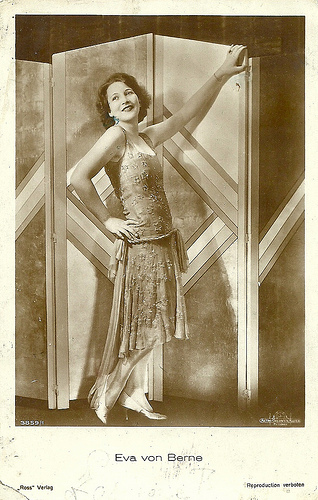
German postcard by Ross Verlag, no. 3859/1, 1928-1929. Photo: Metro-Goldwyn-Mayer. Collection: Didier Hanson.
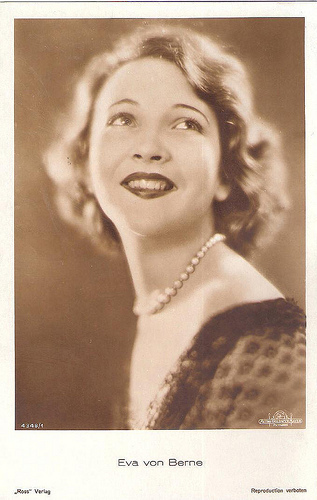
German postcard by Ross Verlag, no. 4348/1/1, 1929-1930. Photo: Metro-Goldwyn-Mayer. Collection: Dutchfan33 (Flickr).
The Quest for Another Garbo
Eva von Berne was born Genofeva Plentzner von Scharneck in Sarajevo, Austria-Hungary (now Bosnia and Herzegovina) in 1910. Eva fled with her family to Vienna following the outbreak of World War I in 1914.
In Vienna she worked as a teenage model. In the quest to discover 'another Garbo,' M.G.M. production chief Irving Thalberg and his actress wife, Norma Shearer, saw a picture in a newspaper of Eva while on a belated honeymoon to Europe, specifically Vienna in late 1927 - early 1928.
The 17-year-old Plentzner was signed to a contract and arrived in New York in July 1928. She spoke only a couple of words of English, but was the beneficiary of extra publicity by the studio's press department who feared a repeat of their overlooking a potential star in the way they had done with Garbo.
She was renamed Eva von Berne. Unfortunately, the completely untrained Miss von Berne was not prepared for the requirements and pressures of movie stardom. Her greatest fault was being 20 pounds overweight, causing her debut movie opposite M.G.M.'s top male star, John Gilbert, to be delayed while considering whether to replace the 17 year old actress or not.
The cast and crew liked Miss von Berne and vowed to help her during a forced recess in the filming, and have her underweight and skilled enough to resume her ingenue role. She completed Masks of the Devil (Victor Sjöström, 1928) but the damage had already been done.
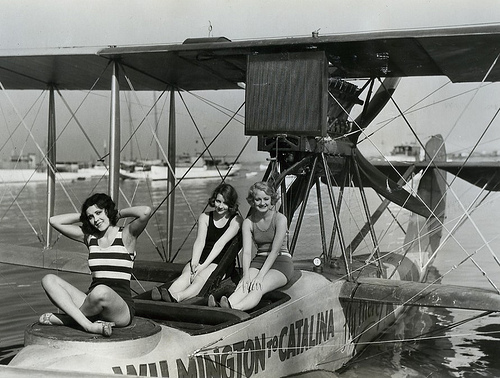
Eva von Berne with Raquel Torres (front) and Josephine Dunn (right). Sourve: Amy Jeanne (Flickr).
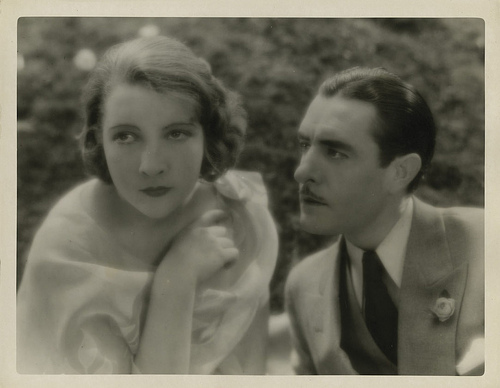
Picture of John Gilbert and Eva von Berne in The Masks of the Devil (1928). Source: Alice Japan (Flickr).
Tragedy was no stranger
Her reviews for Masks of the Devil were respectable, but after no more than six months in the USA, Eva von Berne was sent back to Europe. As 'an American movie star', she was cast in a number of German films.
In Somnambul/The Somnambulist (Adolf Trotz, 1929), she appeared opposite Fritz Kortner and Veit Harlan. Other films were Flucht in die Fremdenlegion/The Legionaire (Louis Ralph, 1929) with Hans Stüwe , the mountain film Der Ruf des Nordens/The Call of the North (Nunzio Malasomma, Mario Bonnard, 1929) with Luis Trenker, and Trust der Diebe/Trust of Thieves (Erich Schönfelder, 1929).
Von Berne gave up on film when the switch to sound was about to take place. In 1930, Hubert Voight, a publicist with M.G.M. erroneously released news of Von Berne's death. This notice was picked up in a number of American newspapers. In a 1980s article in the magazine Sight and Sound, Hubert Voight repeated his belief that Eva von Berne had passed, when in fact, she was very much alive.
After 1930, Von Berne returned to Vienna, where she attended an art school. Eva later worked as an executive in window display for a Vienna department store. During World War II, she fled to Salzburg to be with her family. Eva married Helmut Krauss, a former major of the Austrian army, and became a sculptress. Her work was shown in galleries in several Austrian cities. In a telephone interview with German film journalist Toni Schieck in 2006, Von Berne said she believed it was fortunate that the world thought she was dead because she didn't have to deal with autograph hunters.
Radkins at IMDb : "It is impossible to determine the quality of Miss von Berne's acting skills as Masks of the Devil is a lost film. Tragedy was no stranger to its cast though, as it included John Gilbert who was (one way or another) a casualty of sound and Alma Rubens, an actress reputed to have health issues emanating from a drug dependency."
Eva von Berne died of natural causes in 2010 in Hédervár, Hungary. She was 100.
Tribute to Eva von Berne. Music: The Blue Morris 6 - The Blonde On My Tail. Source: SpyMomentsBack (YouTube).
Sources: (IMDb), Andre Soares (Alt Film Guide), and .

German postcard by Ross Verlag, no. 3859/1, 1928-1929. Photo: Metro-Goldwyn-Mayer. Collection: Didier Hanson.

German postcard by Ross Verlag, no. 4348/1/1, 1929-1930. Photo: Metro-Goldwyn-Mayer. Collection: Dutchfan33 (Flickr).
The Quest for Another Garbo
Eva von Berne was born Genofeva Plentzner von Scharneck in Sarajevo, Austria-Hungary (now Bosnia and Herzegovina) in 1910. Eva fled with her family to Vienna following the outbreak of World War I in 1914.
In Vienna she worked as a teenage model. In the quest to discover 'another Garbo,' M.G.M. production chief Irving Thalberg and his actress wife, Norma Shearer, saw a picture in a newspaper of Eva while on a belated honeymoon to Europe, specifically Vienna in late 1927 - early 1928.
The 17-year-old Plentzner was signed to a contract and arrived in New York in July 1928. She spoke only a couple of words of English, but was the beneficiary of extra publicity by the studio's press department who feared a repeat of their overlooking a potential star in the way they had done with Garbo.
She was renamed Eva von Berne. Unfortunately, the completely untrained Miss von Berne was not prepared for the requirements and pressures of movie stardom. Her greatest fault was being 20 pounds overweight, causing her debut movie opposite M.G.M.'s top male star, John Gilbert, to be delayed while considering whether to replace the 17 year old actress or not.
The cast and crew liked Miss von Berne and vowed to help her during a forced recess in the filming, and have her underweight and skilled enough to resume her ingenue role. She completed Masks of the Devil (Victor Sjöström, 1928) but the damage had already been done.

Eva von Berne with Raquel Torres (front) and Josephine Dunn (right). Sourve: Amy Jeanne (Flickr).

Picture of John Gilbert and Eva von Berne in The Masks of the Devil (1928). Source: Alice Japan (Flickr).
Tragedy was no stranger
Her reviews for Masks of the Devil were respectable, but after no more than six months in the USA, Eva von Berne was sent back to Europe. As 'an American movie star', she was cast in a number of German films.
In Somnambul/The Somnambulist (Adolf Trotz, 1929), she appeared opposite Fritz Kortner and Veit Harlan. Other films were Flucht in die Fremdenlegion/The Legionaire (Louis Ralph, 1929) with Hans Stüwe , the mountain film Der Ruf des Nordens/The Call of the North (Nunzio Malasomma, Mario Bonnard, 1929) with Luis Trenker, and Trust der Diebe/Trust of Thieves (Erich Schönfelder, 1929).
Von Berne gave up on film when the switch to sound was about to take place. In 1930, Hubert Voight, a publicist with M.G.M. erroneously released news of Von Berne's death. This notice was picked up in a number of American newspapers. In a 1980s article in the magazine Sight and Sound, Hubert Voight repeated his belief that Eva von Berne had passed, when in fact, she was very much alive.
After 1930, Von Berne returned to Vienna, where she attended an art school. Eva later worked as an executive in window display for a Vienna department store. During World War II, she fled to Salzburg to be with her family. Eva married Helmut Krauss, a former major of the Austrian army, and became a sculptress. Her work was shown in galleries in several Austrian cities. In a telephone interview with German film journalist Toni Schieck in 2006, Von Berne said she believed it was fortunate that the world thought she was dead because she didn't have to deal with autograph hunters.
Radkins at IMDb : "It is impossible to determine the quality of Miss von Berne's acting skills as Masks of the Devil is a lost film. Tragedy was no stranger to its cast though, as it included John Gilbert who was (one way or another) a casualty of sound and Alma Rubens, an actress reputed to have health issues emanating from a drug dependency."
Eva von Berne died of natural causes in 2010 in Hédervár, Hungary. She was 100.
Tribute to Eva von Berne. Music: The Blue Morris 6 - The Blonde On My Tail. Source: SpyMomentsBack (YouTube).
Sources: (IMDb), Andre Soares (Alt Film Guide), and .
Published on May 28, 2016 22:00
May 27, 2016
Helmut Griem
Handsome and suave German actor Helmut Griem (1932-2004) had a long standing career as stage actor but he is also known for his international film and television work. He is best remembered for the classic musical Cabaret (Bob Fosse, 1972). As the elegant, fabulously decadent baron Max he has trysts with both Sally Bowles (Liza Minnelli) and Brian Roberts (Michael York).
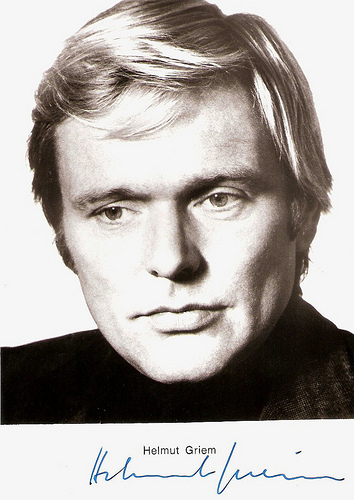
German postcard with autograph.
The Damned
Helmut Griem was born in Hamburg in 1932. He planned to be a journalist, but, after studying literature, science and philosophy, he developed an interest in acting, and made his stage début with a role in N. Richard Nash's The Rainmaker (1956).
Throughout his career Griem would be primarily a stage actor, appearing at the Thalia Theater in Hamburg, the Deutsches Schauspielhaus in Hamburg, the Burgtheater in Vienna, the Staatliche Schauspielbühnen in Berlin, the Munich Kammerspiele, and finally in the Staatstheater am Gärtnerplatz, also in Munich.
He started playing in films in 1960. His debut was Fabrik der Offiziere/The Factory of SS Officers (Frank Wisbar, 1960) with Horst Frank.
The next year he appeared in Bis zum Ende aller Tage/Girl from Hong Kong (Franz Peter Wirth, 1961), Barbara - Wild wie das Meer/Barbara (Frank Wisbar, 1961) with Harriet Andersson, and the comedy Der Traum von Lieschen Müller/The Dream of Lieschen Mueller (Helmut Käutner, 1961) featuring Sonja Ziemann . That year he won the Bambi Award, the oldest media award in Germany. In 1976 he would win his second Bambi.
In the following years he played in European productions such as the Italian war film Oggi a Berlino/East Zone, West Zone (Piero Vivarelli, 1962) and the French production À cause, à cause d'une femme/Because, Because of a Woman (Michel Deville, 1963) starring Jacques Charrier and Mylène Demongeot .
In 1969 Griem had his international breakthrough as the sexy, seductive and thoroughly power hungry SS officer Aschenbach in Visconti's La caduta degli dei/The Damned (Luchino Visconti, 1969). This film about the dramatic collapse of a wealthy, industrialist family during the reign of the Third Reich, starred Dirk Bogarde , Ingrid Thulin, Charlotte Rampling and Helmut Berger . Three years later Griem appeared again opposite Berger in Ludwig (Luchino Visconti, 1972) about the mad and tragic king of Bavaria.
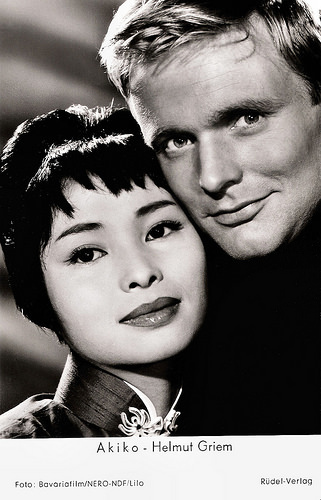
German postcard by Rüdel-Verlag. Photo: Bavaria / NERO / NDF / Lilo. Publicity still for Bis zum Ende aller Tage/Girl from Hong Kong (Franz Peter Wirth, 1961) with Akiko Wakabayashi.
Bisexual Baron
Helmut Griem's most famous role is the rich, bisexual Baron Maximilian von Heune in the Oscar winning Cabaret (Bob Fosse, 1972). Reviewing Cabaret in Monthly Film Bulletin, John Russell Taylor noted: "Helmut Griem as Max manages just the right ironical throwaway charm and erotic confidence to convince us that he could have captivated both sexes with equal ease."
He also played memorable parts opposite Brian Keith in The McKenzie Break (Lamont Johnson, 1970), opposite Senta Berger in Die Moral der Ruth Halbfass/Morals of Ruth Halbfass (Volker Schlöndorff, 1972), opposite Hanna Schygulla in Ansichten eines Clowns/The Clown (Voytech Jasny, 1975), opposite Jacques Perrin in Il deserto dei tartari/The Desert of the Tartars (Valerio Zurlini, 1976), and opposite Romy Schneider in La passante de Sans-Souci/The Passerby (Jacques Rouffio, 1982).
In these films Griem represented the archetypal arrogant, duplicitous and sometimes downright ruthless German. One of his biggest international films was Voyage of the Damned (Stuart Rosenberg, 1976), the true story of a ship full of Jewish refugees from Germany who are refused entry to a succession of foreign ports, just months before the outbreak of war.
In the early 1980s he also appeared in small but interesting German films, including Malou (Janine Meerapfel, 1981), Stachel im Fleisch/A Thorn in the Flesh (Heidi Genée, 1981), and the biography Caspar David Friedrich - Grenzen der Zeit/Boundaries of Time: Caspar David Friedrich (Ulrich Schamoni, 1986).
On TV he appeared in the mini-series Berlin Alexanderplatz (Rainer Werner Fassbinder, 1980) and starred in the NBC series Peter the Great (Marvin J. Chomsky, Lawrence Schiller, 1986), portraying the formidable Tsar's lifelong friend and 'right hand' Alexander Menshikov, alongside Maximilian Schell .
Griem stopped acting in film in the late 1980s but continued to appear on German television and on stage. In the theatre he also worked as a director of such plays as Entertaining Mr. Sloane (by Joe Orton), Long Day's Journey into Night (Eugene O'Neill), and Death of a Salesman (Arthur Miller) in which he also played Willy Loman himself. His last film was Brennendes Herz/Burning Heart (Peter Patzak, 1995) with Dominique Sanda and Werner Herzog.
Helmut Griem died in 2004 in a hospital in Munich, Germany. He was 72.
Trailer of The Damned (Luchino Visconti, 1969). Source: troz2000 (YouTube).
Trailer of The McKenzie Break (Lamont Johnson, 1970). Source: MovieZoneAustralia (YouTube).
Trailer of Cabaret (Bob Fosse, 1972). Source: Warnervod (YouTube).
Trailer of Il deserto dei tartari/The Desert of the Tartars (Valerio Zurlini, 1976). Source: Danios 12345 (YouTube).
Sources: Tom Vallance (The Independent), Brian Pendreigh (The Herald), Wikipedia and .

German postcard with autograph.
The Damned
Helmut Griem was born in Hamburg in 1932. He planned to be a journalist, but, after studying literature, science and philosophy, he developed an interest in acting, and made his stage début with a role in N. Richard Nash's The Rainmaker (1956).
Throughout his career Griem would be primarily a stage actor, appearing at the Thalia Theater in Hamburg, the Deutsches Schauspielhaus in Hamburg, the Burgtheater in Vienna, the Staatliche Schauspielbühnen in Berlin, the Munich Kammerspiele, and finally in the Staatstheater am Gärtnerplatz, also in Munich.
He started playing in films in 1960. His debut was Fabrik der Offiziere/The Factory of SS Officers (Frank Wisbar, 1960) with Horst Frank.
The next year he appeared in Bis zum Ende aller Tage/Girl from Hong Kong (Franz Peter Wirth, 1961), Barbara - Wild wie das Meer/Barbara (Frank Wisbar, 1961) with Harriet Andersson, and the comedy Der Traum von Lieschen Müller/The Dream of Lieschen Mueller (Helmut Käutner, 1961) featuring Sonja Ziemann . That year he won the Bambi Award, the oldest media award in Germany. In 1976 he would win his second Bambi.
In the following years he played in European productions such as the Italian war film Oggi a Berlino/East Zone, West Zone (Piero Vivarelli, 1962) and the French production À cause, à cause d'une femme/Because, Because of a Woman (Michel Deville, 1963) starring Jacques Charrier and Mylène Demongeot .
In 1969 Griem had his international breakthrough as the sexy, seductive and thoroughly power hungry SS officer Aschenbach in Visconti's La caduta degli dei/The Damned (Luchino Visconti, 1969). This film about the dramatic collapse of a wealthy, industrialist family during the reign of the Third Reich, starred Dirk Bogarde , Ingrid Thulin, Charlotte Rampling and Helmut Berger . Three years later Griem appeared again opposite Berger in Ludwig (Luchino Visconti, 1972) about the mad and tragic king of Bavaria.

German postcard by Rüdel-Verlag. Photo: Bavaria / NERO / NDF / Lilo. Publicity still for Bis zum Ende aller Tage/Girl from Hong Kong (Franz Peter Wirth, 1961) with Akiko Wakabayashi.
Bisexual Baron
Helmut Griem's most famous role is the rich, bisexual Baron Maximilian von Heune in the Oscar winning Cabaret (Bob Fosse, 1972). Reviewing Cabaret in Monthly Film Bulletin, John Russell Taylor noted: "Helmut Griem as Max manages just the right ironical throwaway charm and erotic confidence to convince us that he could have captivated both sexes with equal ease."
He also played memorable parts opposite Brian Keith in The McKenzie Break (Lamont Johnson, 1970), opposite Senta Berger in Die Moral der Ruth Halbfass/Morals of Ruth Halbfass (Volker Schlöndorff, 1972), opposite Hanna Schygulla in Ansichten eines Clowns/The Clown (Voytech Jasny, 1975), opposite Jacques Perrin in Il deserto dei tartari/The Desert of the Tartars (Valerio Zurlini, 1976), and opposite Romy Schneider in La passante de Sans-Souci/The Passerby (Jacques Rouffio, 1982).
In these films Griem represented the archetypal arrogant, duplicitous and sometimes downright ruthless German. One of his biggest international films was Voyage of the Damned (Stuart Rosenberg, 1976), the true story of a ship full of Jewish refugees from Germany who are refused entry to a succession of foreign ports, just months before the outbreak of war.
In the early 1980s he also appeared in small but interesting German films, including Malou (Janine Meerapfel, 1981), Stachel im Fleisch/A Thorn in the Flesh (Heidi Genée, 1981), and the biography Caspar David Friedrich - Grenzen der Zeit/Boundaries of Time: Caspar David Friedrich (Ulrich Schamoni, 1986).
On TV he appeared in the mini-series Berlin Alexanderplatz (Rainer Werner Fassbinder, 1980) and starred in the NBC series Peter the Great (Marvin J. Chomsky, Lawrence Schiller, 1986), portraying the formidable Tsar's lifelong friend and 'right hand' Alexander Menshikov, alongside Maximilian Schell .
Griem stopped acting in film in the late 1980s but continued to appear on German television and on stage. In the theatre he also worked as a director of such plays as Entertaining Mr. Sloane (by Joe Orton), Long Day's Journey into Night (Eugene O'Neill), and Death of a Salesman (Arthur Miller) in which he also played Willy Loman himself. His last film was Brennendes Herz/Burning Heart (Peter Patzak, 1995) with Dominique Sanda and Werner Herzog.
Helmut Griem died in 2004 in a hospital in Munich, Germany. He was 72.
Trailer of The Damned (Luchino Visconti, 1969). Source: troz2000 (YouTube).
Trailer of The McKenzie Break (Lamont Johnson, 1970). Source: MovieZoneAustralia (YouTube).
Trailer of Cabaret (Bob Fosse, 1972). Source: Warnervod (YouTube).
Trailer of Il deserto dei tartari/The Desert of the Tartars (Valerio Zurlini, 1976). Source: Danios 12345 (YouTube).
Sources: Tom Vallance (The Independent), Brian Pendreigh (The Herald), Wikipedia and .
Published on May 27, 2016 22:00
May 26, 2016
EFSP's Dazzling Dozen: The Wheel Turns
La Roue Tourne is a French association that supports actors in need and many of the French stars on EFSP were helped by this organisation after their heydays. La Roue Tourne (the wheel turns) was founded by actor Paul Azaïs in 1957 and from the beginning the intention is that artists help other artists in need. Artists who need access to legal, social, medical and financial assistance or who live in solitude. Many film stars support the association and La Roue Tourne is promoted with their postcards. EFSP salutes this act of solidarity.
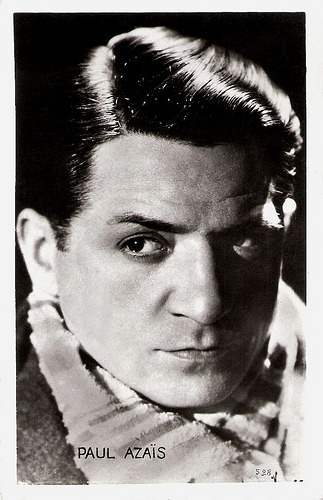
Paul Azaïs . French postcard, no. 528.
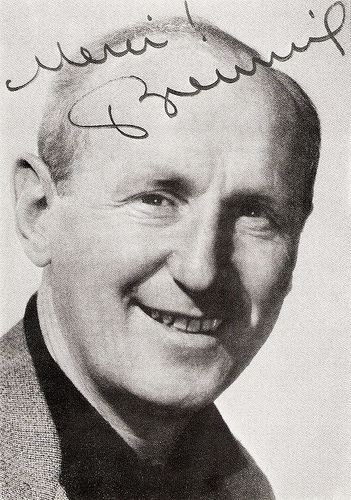
Bourvil . French postcard by La Roue Tourne, Paris, no. 1095.
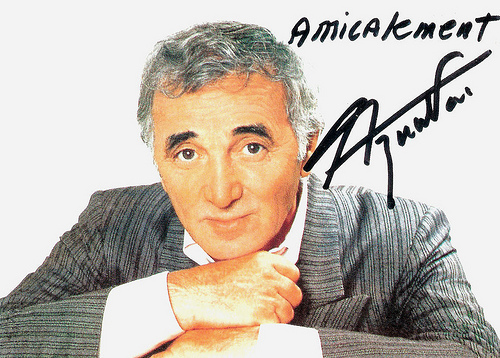
Charles Aznavour . French postcard by La Roue Tourne, Paris.
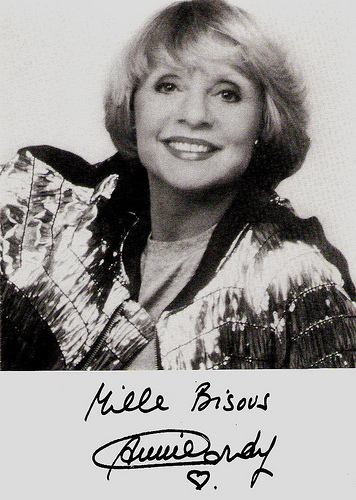
Annie Cordy . French postcard by La Roue Tourne, Paris.
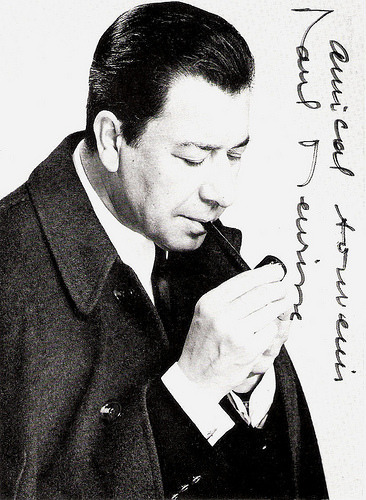
Paul Meurisse . French postcard by La Roue Tourne, Paris.
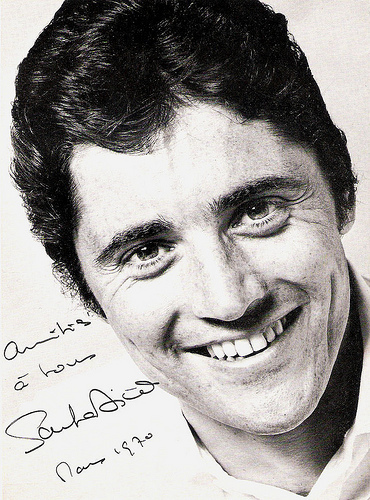
Sacha Distel . French postcard by La Roue Tourne, Paris. Autographed in 1970.
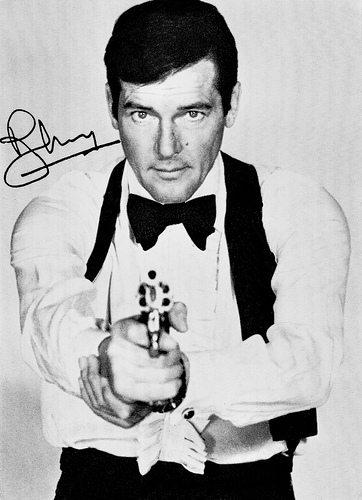
Roger Moore . French postcard by La Roue Tourne, Paris.
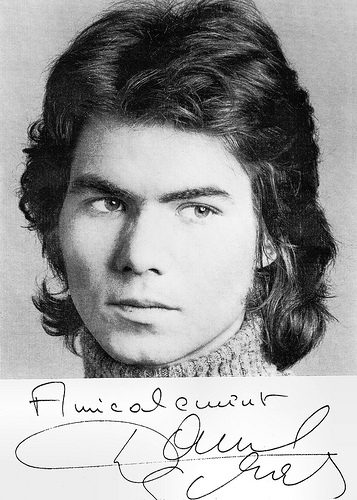
Daniel Guichard. French postcard by La Roue Tourne, Paris.
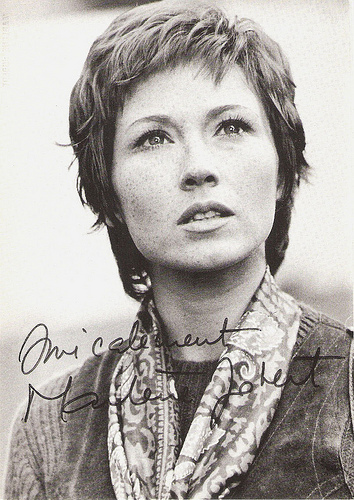
Marlène Jobert . French postcard by La Roue Tourne, Paris.
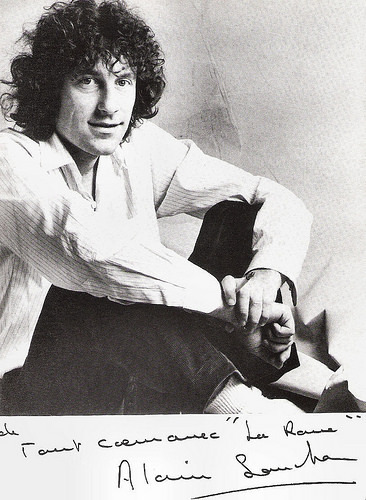
Alain Souchon. French postcard by La Roue Tourne, Paris.
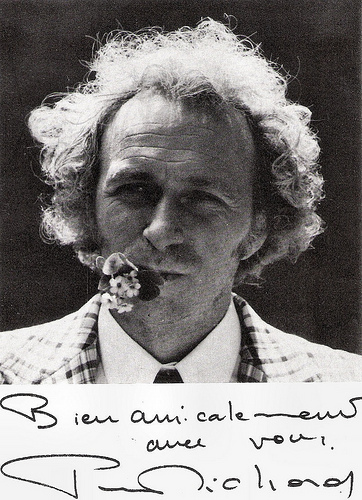
Pierre Richard . French postcard by La Roue Tourne, Paris.
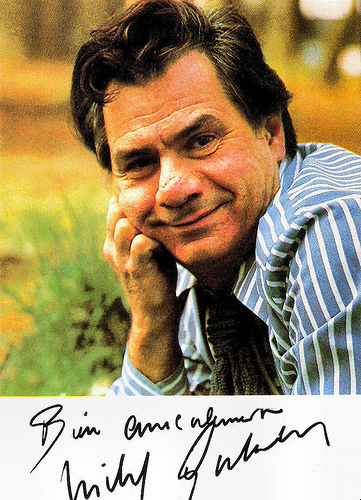
Michel Galabru . French postcard by La Roue Tourne, Paris.
Source: Wikipedia (French).
This is a post for Postcard Friendship Friday, hosted by Beth at the The Best Hearts are Crunchy. You can visit her by clicking on the button below.


Paul Azaïs . French postcard, no. 528.

Bourvil . French postcard by La Roue Tourne, Paris, no. 1095.

Charles Aznavour . French postcard by La Roue Tourne, Paris.

Annie Cordy . French postcard by La Roue Tourne, Paris.

Paul Meurisse . French postcard by La Roue Tourne, Paris.

Sacha Distel . French postcard by La Roue Tourne, Paris. Autographed in 1970.

Roger Moore . French postcard by La Roue Tourne, Paris.

Daniel Guichard. French postcard by La Roue Tourne, Paris.

Marlène Jobert . French postcard by La Roue Tourne, Paris.

Alain Souchon. French postcard by La Roue Tourne, Paris.

Pierre Richard . French postcard by La Roue Tourne, Paris.

Michel Galabru . French postcard by La Roue Tourne, Paris.
Source: Wikipedia (French).
This is a post for Postcard Friendship Friday, hosted by Beth at the The Best Hearts are Crunchy. You can visit her by clicking on the button below.

Published on May 26, 2016 22:00
May 25, 2016
Leni Riefenstahl
Leni Riefenstahl (1902-2003) was the notorious director of Triumph des Willens (1935), a fascinating propaganda documentary about Adolf Hitler and the Third Reich, commissioned by the Nazi government. Before she started directing films, she worked as a dancer and on screen she became a star in the mountain films, directed by Arnold Fanck.
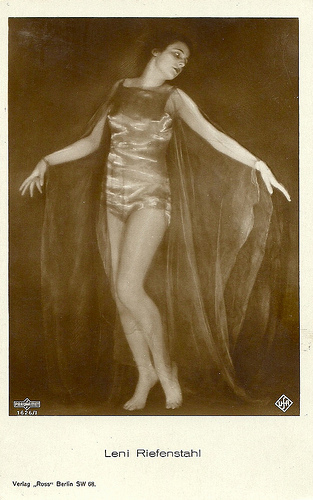
German postcard by Ross Verlag, no. 1626/1, 1927-1928. Photo: Ufa / Parufamet. Collection: Didier Hanson.
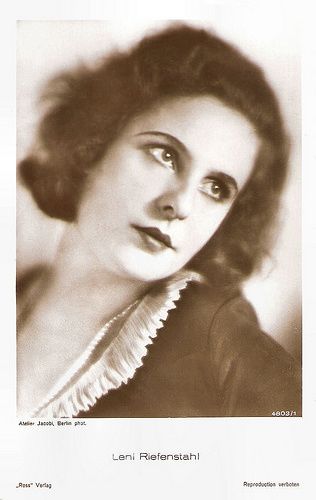
German postcard by Ross Verlag, no. 4803/1, 1929-1930. Photo: Atelier Jacobi, Berlin. Collection: Egbert Barten.
The Perfect German Female
Helene Bertha Amalie 'Leni' Riefenstahl was born in Berlin, German Empire in 1902. Her family was Lutheran Protestant and she had a brother, Heinz, who was killed on the Eastern Front in World War II.
Her father, Alfred Theodor Paul Riefenstahl, owned a successful heating and ventilation company and wanted his daughter to follow him into the business world. Leni was athletic, and at the age of twelve joined a gymnastic and swim club. Without her father's knowledge, she enrolled in dance and ballet classes at the Grimm-Reiter Dance School in Berlin in 1918, where she quickly became a star pupil.
Riefenstahl later also studied dance with Jutta Klamt, Eugenie Eduardova and Mary Wigman. She became well known for her self-styled interpretive dancing skills. She travelled across Europe with Max Reinhardt in a show funded by Jewish producer Harry Sokal. She appeared with Wigman in the documentary Wege zu Kraft und Schönheit - Ein Film über moderne Körperkultur/The Way to Strength and Health: a film of modern body culture (Nicholas Kaufmann, Wilhelm Prager, 1925), an artifact of the Naturist fad that swept Germany at this time.
Riefenstahl began to suffer foot injuries that led to knee surgery, which threatened her dance career. A poster for the mountain film Der Berg des Schicksals/The Mountain of Destiny (Arnold Fanck, 1924) inspired her to move into film acting. She got in touch with director Arnold Fanck, who was the pioneer of the mountain film genre.
Riefenstahl persuaded Fanck to feature her in his next film, Der heilige Berg/The Holy Mountain (Arnold Fanck, 1926) with Luis Trenker and Frieda Richard. The film cost 1.5 million Reichsmarks to produce, and was released during the 1926 Christmas season. Der heilige Berg/The Holy Mountain was popular in Berlin, where sold out performances extended its premiere run for five weeks. The film was also screened in Britain, France and US and was the first international success of its director
Between 1926 and 1931, Leni Riefenstahl starred in five successful films. First she made Der Große Sprung/The Great Leap (Arnold Fanck, 1927) and Das Schicksal derer von Habsburg/Fate of the House of Habsburg (Rolf Raffé, 1928). The film that brought Riefenstahl into the limelight was Fanck's Die Weisse Hölle vom Piz Palü/The White Hell of Piz Palü (Arnold Fanck, G. W. Pabst, 1929) with Gustav Diessl . Her fame spread to countries outside Germany. Her next two films were Stürme über dem Mont Blanc/Storm Over Mont Blanc (Arnold Fanck, 1930) with Sepp Rist , and Der Weisse Rausch/The White Ecstasy (Arnold Fanck, 1931).
From Arnold Fanck, she had learned acting but also film editing techniques. His use of cinematic technique - filters, special film stock, slow motion - to endow magnificent natural scenery with dramatic stature - provided her with key elements of her towering visual style and fostered her technical skill.
Leni Riefenstahl decided to try to produce and direct her own film. It was called Das Blaue Licht/The Blue Light (1932), co-written by Carl Mayer and Béla Balázs. In the film, Riefenstahl played an innocent peasant girl in the Tyrolean mountains who is hated and cast out by the villagers because they think she is diabolic. She is protected by a secret cave of blue crystals. With the blue light, she lures young men to their deaths. The film attracted the attention of Adolf Hitler, who saw talent in Riefenstahl and arranged a meeting. He believed Riefenstahl epitomised the perfect German female.
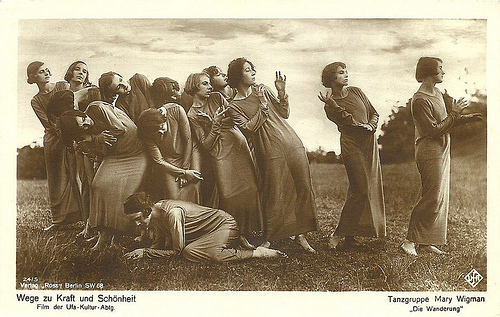
German postcard by Ross Verlag, Berlin, no. 24/5. Photo: Ufa. Publicity still for Wege zu Kraft und Schönheit/Ways to Strength and Beauty (1925, Nicholas Kaufmann, Wilhelm Prager). Pictured are members of the Tanzgruppe Mary Wigman performing Die Wanderung (The Hike). Collection: Didier Hanson.
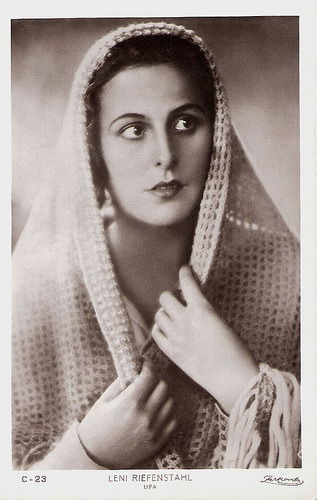
Spanish postcard, no. C-23. Photo: Ufa. Publicity still for Die weiße Hölle vom Piz Palü//The White Hell of Piz Palü (Arnold Fanck, G. W. Pabst, 1929).
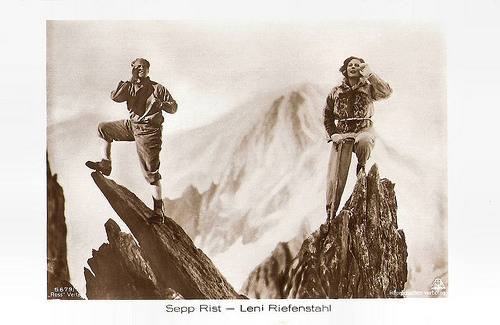
German postcard by Ross Verlag, no. 5679/1, 1930-1931. Photo: Aafa-Film. Publicity still for Stürme über dem Mont Blanc/Storm Over Mont Blanc (Arnold Fanck, 1930) with Sepp Rist .
A friendly relationship with Hitler
In 1933, Leni Riefenstahl appeared in the American-German co-productions SOS Eisberg (Arnold Fanck, 1933; German version) and SOS Iceberg (Tay Garnett, 1933; US version). The two versions were filmed simultaneously in English and German and produced and distributed by Universal Studios. Riefenstahl co-starred with Gustav Diessl and Ernst Udet in S.O.S. Eisberg, and with Gibson Gowland and Rod La Rocque in S.O.S. Iceberg. Her part in SOS Iceberg would be her only English language role in film.
Riefenstahl heard Nazi Party (NSDAP) leader Adolf Hitler speak at the Berlin Sportpalast in 1932 and by her own account, she was mesmerised by his talent as a public speaker. After meeting Hitler, Riefenstahl was offered the opportunity to direct Der Sieg des Glaubens/The Victory of Faith (1933), an hour-long propaganda film about the fifth Nuremberg Rally in 1933. Riefenstahl agreed to direct the movie. She and Hitler got on well, forming a friendly relationship. The propaganda film was funded entirely by the NSDAP.
Impressed with Riefenstahl's work, Hitler asked her to film Triumph des Willens/Triumph of the Will (1935), a new propaganda film about the the 1934 Nazi Party Congress in Nuremberg. More than 700,000 Nazi supporters attended the rally. The film contains excerpts from speeches given by Nazi leaders at the Congress, including Adolf Hitler, Rudolf Hess, and Julius Streicher, interspersed with footage of massed Sturmabteilung and Schutzstaffel troops and public reaction.
Riefenstahl's techniques — such as moving cameras, aerial photography, the use of long focus lenses to create a distorted perspective, and the revolutionary approach to the use of music and cinematography — made Triumph des Willens/Triumph of the Will a prominent example of propaganda in film history.
Riefenstahl won several awards, not only in Germany but also in the United States, France, Sweden, and other countries. Despite allegedly vowing not to make any more films about the Nazi Party, Riefenstahl made the 28-minute Tag der Freiheit: Unsere WehrmachtDay of Freedom: Our Armed Forces (1935) about the German Army.
Hitler then invited Riefenstahl to film the 1936 Summer Olympics scheduled to be held in Berlin. She visited Greece to take footage of the route of the inaugural torch relay and the games' original site at Olympia, where she was aided by Greek photographer Nelly's. This material became the two-part Olympia (Festival Of Nations/ Festival Of Beauty) (1938), a hugely successful film which has since been widely noted for its technical and aesthetic achievements.
Riefenstahl began work on the opera film Tiefland/Lowlands. On Hitler's direct order, the German government paid her seven million Reichsmarks in compensation. Sinti and Roma people from the Marzahn detention camp near Berlin were compelled to work as extras. Almost to the end of her life, despite overwhelming evidence that the concentration camp occupants had been forced to work on the film unpaid, Riefenstahl continued to maintain all the film extras survived and that she had met several of them after the war.
In October 1944 the production of Tiefland moved to Barrandov Studios in Prague for interior filming. Lavish sets made these shots some of the most costly of the film. The film was not edited and released until almost ten years later. Tiefland would be her last feature film.
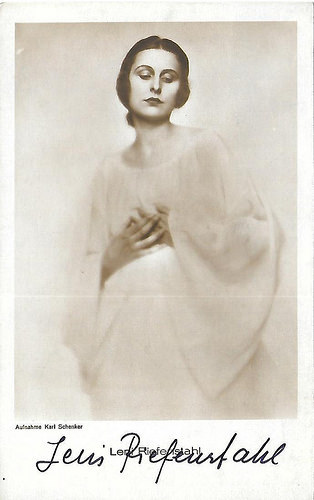
German postcard. Photo: Karl Schenker. Collection: Didier Hanson.
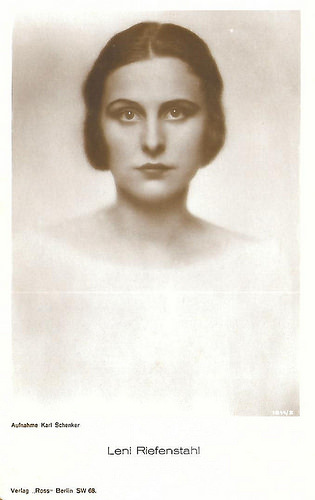
German postcard by Ross Verlag, no. 1814/2, 1927-1928. Photo: Karl Schenker. Collection: Didier Hanson.
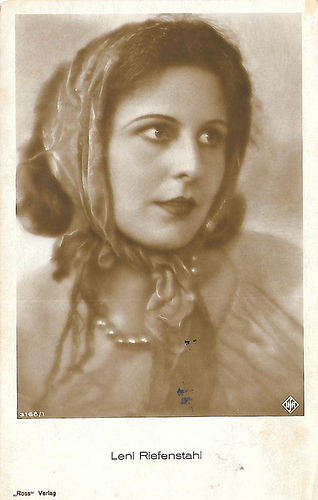
German postcard by Ross Verlag, no. 3168/1, 1929-1930. Photo: Ufa. Collection: Didier Hanson.
Fellow Traveller
In 1945, after the war, Leni Riefenstahl was arrested at her chalet in Kitzbühel in the Tyrol by US soldiers. Throughout 1945 to 1948, she was held by various Allied-controlled prison camps across Germany. She was also under house arrest for a period of time. She had never been a Nazi party member and was cleared of active involvement by a de-Nazification tribunal. She was declared a Mitläufer or fellow traveller, which disbarred her from ever seeking public office.
During the 1950s and 1960s, she tried many times to make more films, but was met with resistance, public protests and sharp criticism. Triumph des Willens and her other work for the Nazis had significantly damaged her career and reputation. Despite her protests to the contrary, Riefenstahl was considered an intricate part of the Third Reich's propaganda machine.
In the 1960s, Riefenstahl discovered Africa and reinvented herself as a still photographer. She published two photo books on the Nuba tribes, The Nuba and The Nuba of Kau. In 1968, she began a lifelong companionship with her cameraman Horst Kettner. She was 60 and he was 20. He assisted her with her photographs.
She also photographed the 1972 Olympic Games in Munich. In 1978, Riefenstahl published a book of her sub-aquatic photographs called Korallengärten (Coral Gardens), followed by the 1990 book Wunder unter Wasser (Wonder under Water). Riefenstahl also released the autobiography A Memoir (1995).
Leni Riefenstahl died of cancer in 2003 in Pöcking, Germany at the age of 101. She was buried at Munich Waldfriedhof. Riefenstahl was married twice. From 1944 till 1947, she was married to Peter Jacob. Shortly before her death, she married her longtime companion Horst Kettner.
German trailer for Der Weisse Rausch/The White Ecstasy (1931). Source: FREERIDE FILMFESTIVAL (YouTube).
German trailer for Das Blaue Licht/The Blue Light (1932). Source: Filmportal (YouTube).
Trailer Olympia. Source: Jesse Abdenour (YouTube).
Clip from Tiefland/Lowlands (1954). Source: Канал пользователя samoslav01 (YouTube).
Sources: Richard Falcon (The Guardian), Rainer Rother (Leni Riefenstahl: The Seduction of Genius), Wikipedia and .

German postcard by Ross Verlag, no. 1626/1, 1927-1928. Photo: Ufa / Parufamet. Collection: Didier Hanson.

German postcard by Ross Verlag, no. 4803/1, 1929-1930. Photo: Atelier Jacobi, Berlin. Collection: Egbert Barten.
The Perfect German Female
Helene Bertha Amalie 'Leni' Riefenstahl was born in Berlin, German Empire in 1902. Her family was Lutheran Protestant and she had a brother, Heinz, who was killed on the Eastern Front in World War II.
Her father, Alfred Theodor Paul Riefenstahl, owned a successful heating and ventilation company and wanted his daughter to follow him into the business world. Leni was athletic, and at the age of twelve joined a gymnastic and swim club. Without her father's knowledge, she enrolled in dance and ballet classes at the Grimm-Reiter Dance School in Berlin in 1918, where she quickly became a star pupil.
Riefenstahl later also studied dance with Jutta Klamt, Eugenie Eduardova and Mary Wigman. She became well known for her self-styled interpretive dancing skills. She travelled across Europe with Max Reinhardt in a show funded by Jewish producer Harry Sokal. She appeared with Wigman in the documentary Wege zu Kraft und Schönheit - Ein Film über moderne Körperkultur/The Way to Strength and Health: a film of modern body culture (Nicholas Kaufmann, Wilhelm Prager, 1925), an artifact of the Naturist fad that swept Germany at this time.
Riefenstahl began to suffer foot injuries that led to knee surgery, which threatened her dance career. A poster for the mountain film Der Berg des Schicksals/The Mountain of Destiny (Arnold Fanck, 1924) inspired her to move into film acting. She got in touch with director Arnold Fanck, who was the pioneer of the mountain film genre.
Riefenstahl persuaded Fanck to feature her in his next film, Der heilige Berg/The Holy Mountain (Arnold Fanck, 1926) with Luis Trenker and Frieda Richard. The film cost 1.5 million Reichsmarks to produce, and was released during the 1926 Christmas season. Der heilige Berg/The Holy Mountain was popular in Berlin, where sold out performances extended its premiere run for five weeks. The film was also screened in Britain, France and US and was the first international success of its director
Between 1926 and 1931, Leni Riefenstahl starred in five successful films. First she made Der Große Sprung/The Great Leap (Arnold Fanck, 1927) and Das Schicksal derer von Habsburg/Fate of the House of Habsburg (Rolf Raffé, 1928). The film that brought Riefenstahl into the limelight was Fanck's Die Weisse Hölle vom Piz Palü/The White Hell of Piz Palü (Arnold Fanck, G. W. Pabst, 1929) with Gustav Diessl . Her fame spread to countries outside Germany. Her next two films were Stürme über dem Mont Blanc/Storm Over Mont Blanc (Arnold Fanck, 1930) with Sepp Rist , and Der Weisse Rausch/The White Ecstasy (Arnold Fanck, 1931).
From Arnold Fanck, she had learned acting but also film editing techniques. His use of cinematic technique - filters, special film stock, slow motion - to endow magnificent natural scenery with dramatic stature - provided her with key elements of her towering visual style and fostered her technical skill.
Leni Riefenstahl decided to try to produce and direct her own film. It was called Das Blaue Licht/The Blue Light (1932), co-written by Carl Mayer and Béla Balázs. In the film, Riefenstahl played an innocent peasant girl in the Tyrolean mountains who is hated and cast out by the villagers because they think she is diabolic. She is protected by a secret cave of blue crystals. With the blue light, she lures young men to their deaths. The film attracted the attention of Adolf Hitler, who saw talent in Riefenstahl and arranged a meeting. He believed Riefenstahl epitomised the perfect German female.

German postcard by Ross Verlag, Berlin, no. 24/5. Photo: Ufa. Publicity still for Wege zu Kraft und Schönheit/Ways to Strength and Beauty (1925, Nicholas Kaufmann, Wilhelm Prager). Pictured are members of the Tanzgruppe Mary Wigman performing Die Wanderung (The Hike). Collection: Didier Hanson.

Spanish postcard, no. C-23. Photo: Ufa. Publicity still for Die weiße Hölle vom Piz Palü//The White Hell of Piz Palü (Arnold Fanck, G. W. Pabst, 1929).

German postcard by Ross Verlag, no. 5679/1, 1930-1931. Photo: Aafa-Film. Publicity still for Stürme über dem Mont Blanc/Storm Over Mont Blanc (Arnold Fanck, 1930) with Sepp Rist .
A friendly relationship with Hitler
In 1933, Leni Riefenstahl appeared in the American-German co-productions SOS Eisberg (Arnold Fanck, 1933; German version) and SOS Iceberg (Tay Garnett, 1933; US version). The two versions were filmed simultaneously in English and German and produced and distributed by Universal Studios. Riefenstahl co-starred with Gustav Diessl and Ernst Udet in S.O.S. Eisberg, and with Gibson Gowland and Rod La Rocque in S.O.S. Iceberg. Her part in SOS Iceberg would be her only English language role in film.
Riefenstahl heard Nazi Party (NSDAP) leader Adolf Hitler speak at the Berlin Sportpalast in 1932 and by her own account, she was mesmerised by his talent as a public speaker. After meeting Hitler, Riefenstahl was offered the opportunity to direct Der Sieg des Glaubens/The Victory of Faith (1933), an hour-long propaganda film about the fifth Nuremberg Rally in 1933. Riefenstahl agreed to direct the movie. She and Hitler got on well, forming a friendly relationship. The propaganda film was funded entirely by the NSDAP.
Impressed with Riefenstahl's work, Hitler asked her to film Triumph des Willens/Triumph of the Will (1935), a new propaganda film about the the 1934 Nazi Party Congress in Nuremberg. More than 700,000 Nazi supporters attended the rally. The film contains excerpts from speeches given by Nazi leaders at the Congress, including Adolf Hitler, Rudolf Hess, and Julius Streicher, interspersed with footage of massed Sturmabteilung and Schutzstaffel troops and public reaction.
Riefenstahl's techniques — such as moving cameras, aerial photography, the use of long focus lenses to create a distorted perspective, and the revolutionary approach to the use of music and cinematography — made Triumph des Willens/Triumph of the Will a prominent example of propaganda in film history.
Riefenstahl won several awards, not only in Germany but also in the United States, France, Sweden, and other countries. Despite allegedly vowing not to make any more films about the Nazi Party, Riefenstahl made the 28-minute Tag der Freiheit: Unsere WehrmachtDay of Freedom: Our Armed Forces (1935) about the German Army.
Hitler then invited Riefenstahl to film the 1936 Summer Olympics scheduled to be held in Berlin. She visited Greece to take footage of the route of the inaugural torch relay and the games' original site at Olympia, where she was aided by Greek photographer Nelly's. This material became the two-part Olympia (Festival Of Nations/ Festival Of Beauty) (1938), a hugely successful film which has since been widely noted for its technical and aesthetic achievements.
Riefenstahl began work on the opera film Tiefland/Lowlands. On Hitler's direct order, the German government paid her seven million Reichsmarks in compensation. Sinti and Roma people from the Marzahn detention camp near Berlin were compelled to work as extras. Almost to the end of her life, despite overwhelming evidence that the concentration camp occupants had been forced to work on the film unpaid, Riefenstahl continued to maintain all the film extras survived and that she had met several of them after the war.
In October 1944 the production of Tiefland moved to Barrandov Studios in Prague for interior filming. Lavish sets made these shots some of the most costly of the film. The film was not edited and released until almost ten years later. Tiefland would be her last feature film.

German postcard. Photo: Karl Schenker. Collection: Didier Hanson.

German postcard by Ross Verlag, no. 1814/2, 1927-1928. Photo: Karl Schenker. Collection: Didier Hanson.

German postcard by Ross Verlag, no. 3168/1, 1929-1930. Photo: Ufa. Collection: Didier Hanson.
Fellow Traveller
In 1945, after the war, Leni Riefenstahl was arrested at her chalet in Kitzbühel in the Tyrol by US soldiers. Throughout 1945 to 1948, she was held by various Allied-controlled prison camps across Germany. She was also under house arrest for a period of time. She had never been a Nazi party member and was cleared of active involvement by a de-Nazification tribunal. She was declared a Mitläufer or fellow traveller, which disbarred her from ever seeking public office.
During the 1950s and 1960s, she tried many times to make more films, but was met with resistance, public protests and sharp criticism. Triumph des Willens and her other work for the Nazis had significantly damaged her career and reputation. Despite her protests to the contrary, Riefenstahl was considered an intricate part of the Third Reich's propaganda machine.
In the 1960s, Riefenstahl discovered Africa and reinvented herself as a still photographer. She published two photo books on the Nuba tribes, The Nuba and The Nuba of Kau. In 1968, she began a lifelong companionship with her cameraman Horst Kettner. She was 60 and he was 20. He assisted her with her photographs.
She also photographed the 1972 Olympic Games in Munich. In 1978, Riefenstahl published a book of her sub-aquatic photographs called Korallengärten (Coral Gardens), followed by the 1990 book Wunder unter Wasser (Wonder under Water). Riefenstahl also released the autobiography A Memoir (1995).
Leni Riefenstahl died of cancer in 2003 in Pöcking, Germany at the age of 101. She was buried at Munich Waldfriedhof. Riefenstahl was married twice. From 1944 till 1947, she was married to Peter Jacob. Shortly before her death, she married her longtime companion Horst Kettner.
German trailer for Der Weisse Rausch/The White Ecstasy (1931). Source: FREERIDE FILMFESTIVAL (YouTube).
German trailer for Das Blaue Licht/The Blue Light (1932). Source: Filmportal (YouTube).
Trailer Olympia. Source: Jesse Abdenour (YouTube).
Clip from Tiefland/Lowlands (1954). Source: Канал пользователя samoslav01 (YouTube).
Sources: Richard Falcon (The Guardian), Rainer Rother (Leni Riefenstahl: The Seduction of Genius), Wikipedia and .
Published on May 25, 2016 22:00
May 24, 2016
Le Grand bleu (1988)
Le Grand bleu/The Big Blue (Luc Besson, 1988) is a beautiful and serene French film. Jean-Marc Barr plays French diver Jacques Mayol, alongside Rosanna Arquette and Jean Reno. Le Grand bleu became the most financially successful film in France in the 1980s.

French postcard by Ciné Passion, no. GB 7. Photo: publicity still for Le Grand Bleu (Luc Besson, 1988) with Jean-Marc Barr .
Eternal Heaven
Le Grand bleu/The Big Blue (1988) is a fictionalised and dramatised story of the friendship and sporting rivalry between two leading contemporary champion free divers in the 20th century: Jacques Mayol (played by Jean-Marc Barr ) and Enzo Maiorca (renamed to Enzo Molinari and played by Jean Reno ), and Mayol's fictionalised relationship with his girlfriend Johana Baker (played by Rosanna Arquette).
The film covers their childhood in 1960s Greece to their deaths in a 1980s Sicilian diving competition. Jacques and Enzo are fascinated by the sea but for different reasons. If Reno devotes all his energies to diving so as to an access to success and glory, the sea is more than this for Jacques.
For Jacques the ocean is a place of athletic competition, an ideal place for rest and entertaining where dolphins are his real and sole friends, and finally it's his eternal heaven. He was born with it, he swears by it and the sea will lead him to his death.
Mayol's and Maiorca's story was heavily adapted for cinema. In real life Mayol lived from 1927 to 2001 and Maiorca retired from diving to politics in the 1980s. Both set no-limits category deep diving records below 100 metres, and Mayol was indeed involved in scientific research into human aquatic potential, but neither reached 400 feet (122 metres) as portrayed in the film, and they were not direct competitors. Mayol himself was a screenwriter for the film.
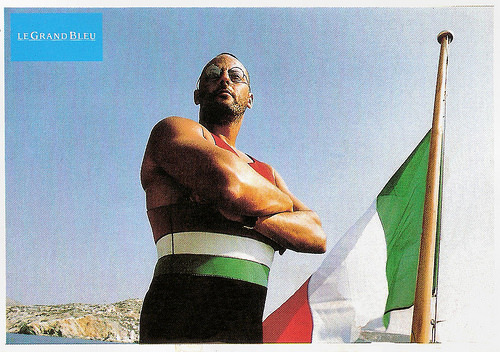
French postcard by Ciné Passion, no. GB 4. Photo: publicity still for Le Grand bleu (Luc Besson, 1988) with Jean Reno .
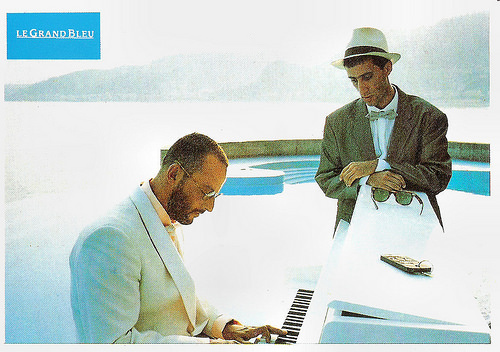
French postcard by Ciné Passion, no. GB 1. Photo: publicity still for Le Grand bleu (Luc Besson, 1988) with Jean Reno and Sergio Castellitto.
Le Look
Luc Besson was initially unsure of whom to cast in the main role of Jacques Mayol. He initially offered the role to Christopher Lambert and Mickey Rourke and even considered himself for the role until someone suggested Jean-Marc Barr . Besson has a cameo appearance as one of the divers in the film.
Le Grand bleu/The Big Blue meant Besson's international breakthrough. It's a key-film which divided the French public between those who saw the film only as a tedious documentary about the ocean and those who acclaimed this as passionate filmmaking.
The film is one of the finest examples of the Cinéma du look visual style if the 1980s. Besson, Jean-Jacques Beineix and Leos Carax are the main directors of 'le look'. Their films had a slick, gorgeous visual style and a focus on young, alienated characters.
Le Grand bleu/The Big Blue is a cult-classic in the diving fraternity. It was nominated for several César Awards and won César Award for Best Music Written for a Film (Eric Serra) and Best Sound in 1989. The film also won France's National Academy of Cinema's Academy Award in 1989.
Besson's film also became one of France's biggest box office hits. It sold 9,193,873 tickets in France alone, and played in French theatres for a year. While popular in Europe, an adaptation for US release was a commercial failure in that country.
DB Dumonteil at IMDb : "Le Grand bleu also ranks among the movies that you must watch rather than telling it. Of course, there isn't almost any plot, dialogues are short and rare but the pictures are gorgeous enough to create an entrancing climate supported by Eric Serra's mesmerising music.
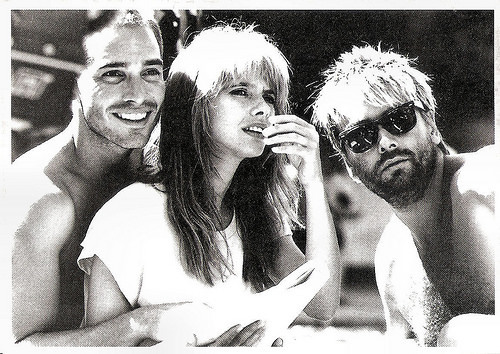
French postcard by Especially for you, Ref. 30. Photo: publicity still for Le Grand bleu (Luc Besson, 1988). Jean-Marc Barr , Rosanna Arquette and Luc Besson at the set.
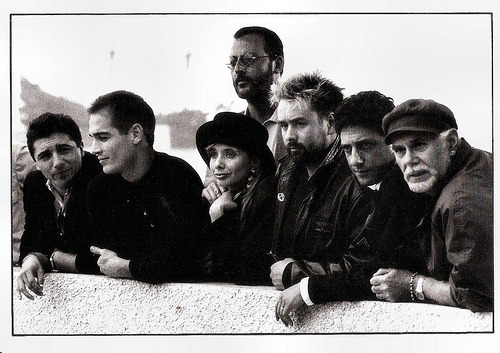
French postcard by News Productions, Beaulmes, no 56063. Photo: Eric Coiffier. Director and cast of Le Grand bleu (Luc Besson, 1988) at the Festival de Cannes, 1988. With in the front row from left to right: Marc Duret, Jean-Marc Barr , Rosanna Arquette, Luc Besson, Sergio Castellitto and Andréas Voutsinas. In the back: Jean Reno.
Sources: DB Dumonteil (IMDb), Wikipedia and IMDb.

French postcard by Ciné Passion, no. GB 7. Photo: publicity still for Le Grand Bleu (Luc Besson, 1988) with Jean-Marc Barr .
Eternal Heaven
Le Grand bleu/The Big Blue (1988) is a fictionalised and dramatised story of the friendship and sporting rivalry between two leading contemporary champion free divers in the 20th century: Jacques Mayol (played by Jean-Marc Barr ) and Enzo Maiorca (renamed to Enzo Molinari and played by Jean Reno ), and Mayol's fictionalised relationship with his girlfriend Johana Baker (played by Rosanna Arquette).
The film covers their childhood in 1960s Greece to their deaths in a 1980s Sicilian diving competition. Jacques and Enzo are fascinated by the sea but for different reasons. If Reno devotes all his energies to diving so as to an access to success and glory, the sea is more than this for Jacques.
For Jacques the ocean is a place of athletic competition, an ideal place for rest and entertaining where dolphins are his real and sole friends, and finally it's his eternal heaven. He was born with it, he swears by it and the sea will lead him to his death.
Mayol's and Maiorca's story was heavily adapted for cinema. In real life Mayol lived from 1927 to 2001 and Maiorca retired from diving to politics in the 1980s. Both set no-limits category deep diving records below 100 metres, and Mayol was indeed involved in scientific research into human aquatic potential, but neither reached 400 feet (122 metres) as portrayed in the film, and they were not direct competitors. Mayol himself was a screenwriter for the film.

French postcard by Ciné Passion, no. GB 4. Photo: publicity still for Le Grand bleu (Luc Besson, 1988) with Jean Reno .

French postcard by Ciné Passion, no. GB 1. Photo: publicity still for Le Grand bleu (Luc Besson, 1988) with Jean Reno and Sergio Castellitto.
Le Look
Luc Besson was initially unsure of whom to cast in the main role of Jacques Mayol. He initially offered the role to Christopher Lambert and Mickey Rourke and even considered himself for the role until someone suggested Jean-Marc Barr . Besson has a cameo appearance as one of the divers in the film.
Le Grand bleu/The Big Blue meant Besson's international breakthrough. It's a key-film which divided the French public between those who saw the film only as a tedious documentary about the ocean and those who acclaimed this as passionate filmmaking.
The film is one of the finest examples of the Cinéma du look visual style if the 1980s. Besson, Jean-Jacques Beineix and Leos Carax are the main directors of 'le look'. Their films had a slick, gorgeous visual style and a focus on young, alienated characters.
Le Grand bleu/The Big Blue is a cult-classic in the diving fraternity. It was nominated for several César Awards and won César Award for Best Music Written for a Film (Eric Serra) and Best Sound in 1989. The film also won France's National Academy of Cinema's Academy Award in 1989.
Besson's film also became one of France's biggest box office hits. It sold 9,193,873 tickets in France alone, and played in French theatres for a year. While popular in Europe, an adaptation for US release was a commercial failure in that country.
DB Dumonteil at IMDb : "Le Grand bleu also ranks among the movies that you must watch rather than telling it. Of course, there isn't almost any plot, dialogues are short and rare but the pictures are gorgeous enough to create an entrancing climate supported by Eric Serra's mesmerising music.

French postcard by Especially for you, Ref. 30. Photo: publicity still for Le Grand bleu (Luc Besson, 1988). Jean-Marc Barr , Rosanna Arquette and Luc Besson at the set.

French postcard by News Productions, Beaulmes, no 56063. Photo: Eric Coiffier. Director and cast of Le Grand bleu (Luc Besson, 1988) at the Festival de Cannes, 1988. With in the front row from left to right: Marc Duret, Jean-Marc Barr , Rosanna Arquette, Luc Besson, Sergio Castellitto and Andréas Voutsinas. In the back: Jean Reno.
Sources: DB Dumonteil (IMDb), Wikipedia and IMDb.
Published on May 24, 2016 22:00
May 23, 2016
Livio Pavanelli
Italian actor Livio Pavanelli (1881-1958) was a star of the Italian and in particular the German silent cinema. He also worked in Italian sound cinema as actor and production manager. And he directed four Italian films, in the silent and the sound era.
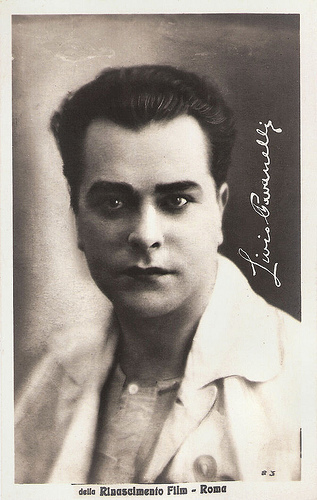
Italian postcard by La Rotofotografia, no. 83. Photo: Rinoscimento Film.

Austrian photo by Willinger, Wien. From Tatiana. Xenia Desni and Livio Pavanelli in the German silent film Die letzte Einquartierung aka Küssen ist keine Sünd'/Kissing is no sin (Rudolf Walther-Fein, Rudolf Dworsky, 1926).
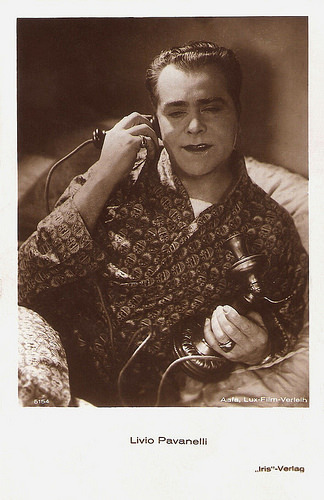
Austrian postcard by Iris Verlag, no. 5154. Photo: Aafa / Lux Film Verleih.
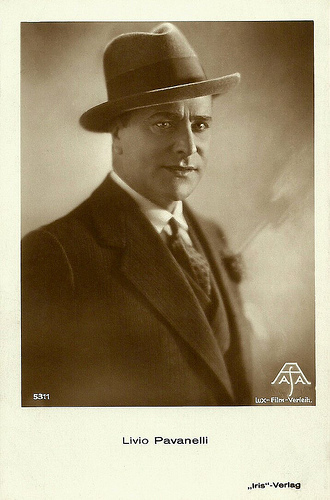
Austrian postcard by Iris Verlag, no. 5311. Photo: Aafa Film / Lux-Film-Verleih.
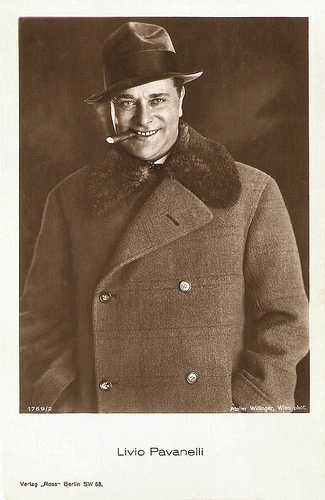
German postcard by Ross Verlag, no. 1769/2, 1927-1928. Photo: Atelier Willinger, Wien (Vienna).
Divas
Livio Cesare Pavanelli was born in Copparo, Italy in 1881. He was member of a big family of farmers and merchants from the Ferrara area. His father Andrea was also a notable patriot in the Italian Risorgimento. As a consequence of financial disasters in the family he moved with his parents to Bologna where he visited the technical school. During his adolescence he wandered around Italy, eager for excitement. When in Venice in 1898, he fell in love with the stage while assisting a show of wandering artists. He performed with various companies like that of Antonio Gandusio, and in 1902 the Venetian company of Emilio Zago. He then shifted to the company of Gustavo Salvini and Ermete Zacconi , before reaching Eleonora Duse ’s company with whom he stayed for 9 years, accompanying her at her foreign tours as well.
In the early 1910s he performed leads in various films, starting in a series of short silent films with Pina Fabbri including Il delitto della via di Nizza (Henri Etievant, 1913) and Il romanzo di due vite/The novel of two lives (Attilio Fabbri, 1913). From 1914 on he starred in a series of films with Hesperia like L’ereditiera/The heiress (Baldassarre Negroni, 1914) and L’agguato/The trap (Guglielmo Zorzi, 1915); with Mercedes Brignone like Il re dell’Atlantico/The king of the Atlantic (Baldassarre Negroni, 1914) and Mezzanotte/Midnight (Augusto Genina, 1915); and with Gianna Terribili-Gonzales.
In 1916-1917 Pavanelli didn’t appear in a film, but in 1918 he was back in business. He starred opposite Francesca Bertini in various parts of the series I sette peccati capitali/The seven capital sins (Camillo De Riso a.o., 1918), La piovra/The Octopus (Edoardo Bencivenga, 1919) and Anima allegra/Happy soul (Roberto Roberti, 1919). He also appeared opposite another diva, Lyda Borelli , in Carnevalesca/Carnival (Amleto Palermi, 1918) and Una notte a Calcutta/A Night in Calcutta (Mario Caserini, 1918). In 1918 he also played Saint Sebastian in Enrico Guazzoni’s epic Fabiola (1918), with Elena Sangro in the title role, and he had a part in the propagandist fake biopic of Francesca Bertini : Mariute (Edoardo Bencivenga, 1918), starring the diva herself.
In those years, Thea Pavanelli aka Thea played with Pavanelli in La reginetta Isotta/The queen Isotta (1918), based on a story by Honoré de Balzac. Reportedly she was his wife, but no additional information is available about this. In the following years, Pavanelli became a superstar of the Italian silent cinema. He was the star of epic films like Il sacco di Roma/The Sack of Rome (Enrico Guazzoni, Giulio Aristide Sartorio, 1920), but he also appeared in a long list of diva films with Pina Menichelli such as La storia di una donna/A Woman's Story (Eugenio Perego, 1920), La verità nuda/Woman Against Woman (Telemaco Ruggeri, 1921), L’età critica/The critical age (Amleto Palermi, 1921), La seconda moglie/The second wife (Amleto Palermi, 1922), and La biondina/The Blonde (Amleto Palermi, 1923).
Other actresses opposite whom Pavanelli acted in the early 1920s were Tilde Kassay, Diomira Jacobini , and Cecyl Tryan . In Saitra la ribelle/Saitra the rebel (Amleto Palermi, 1924), Coiffeur pour dames/Ladies' hairdresser (Amleto Palermi, 1924) and Vedi Napoli, poi muori/You see Naples and then you die (Eugenio Perego, 1924), Pavanelli played opposite Leda Gys . He also played the lead of Turiddu opposite Tina Xeo as Santuzza in the adaptation of Giovanni Verga’s story and Pietro Mascagni’s opera Cavalleria rusticana/Rustic Chivalry (Mario Gargiulo, 1924).
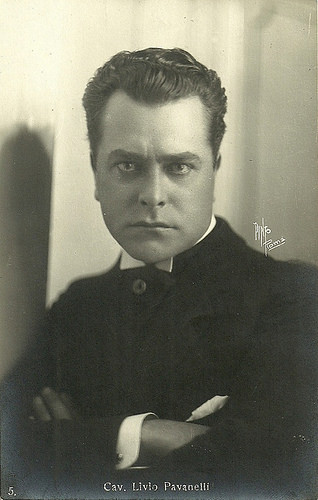
Italian postcard. by Ed. A. Traldi, Milano, no. 5. Photo: Pinto, Roma.
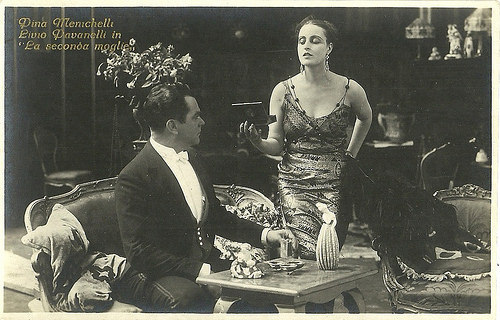
Italian postcard by Ed. G.B. Falci, Milano, no. 262. Pina Menichelli and Livio Pavanelli in La seconda moglie (Amleto Palermi, 1922).
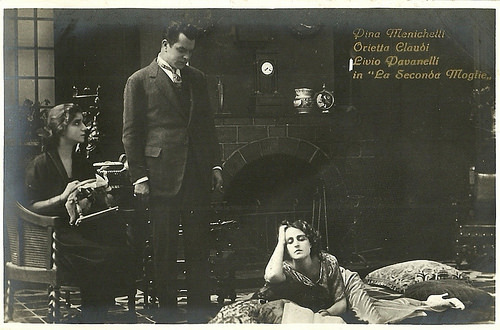
Italian postcard by Ed. G.B. Falci, Milano. Pina Menichelli , Livio Pavanelli and Orietta Claudi in the Italian silent film La seconda moglie (Amleto Palermi, 1922).
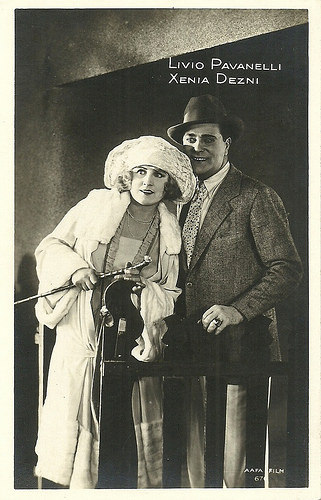
Italian postcard, No. 67?. Photo: Aafa Film. Perhaps for the film German silent film Die letzte Einquartierung aka Küssen ist keine Sünd'/Kissing is no sin (Rudolf Walther-Fein, Rudolf Dworsky, 1926) with Livio Pavanelli and Xenia Desni .
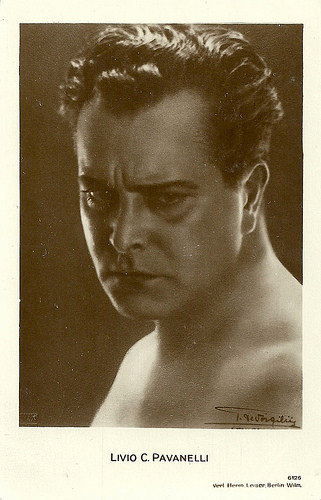
German postcard by Verlag Hermann Leiser, Berlin-Wilm., no 6126. Photo: T. De Virgiliis.
Weimar Cinema
In 1924, there was a serious crisis in the Italian cinema. Livio Pavanelli moved to Austria first and then to Germany, where he could continue his successful career. He performed opposite many female stars of the Weimar cinema, such as Lee Parry in Die schönste Frau der Welt/The Most Beautiful Woman of the World (Richard Eichberg, 1924), Fern Andra in Die Liebe is der Frauen Macht/Love is the Women's Power (Erich Engel, Georg Bluen, 1924), Liane Haid in Ich liebe dich!/I Love You (Paul L. Stein, 1924), Im weissen Rössl/The White Horse Inn (Richard Oswald, 1926), and Als ich wieder kam (1926); and Ossi Oswalda in Niniche (1924).
Other films were Der Ritt in die Sonne/The ride in the sun (Georg Jacoby, 1926), Das Gasthaus zur Ehe/The Marriage Guesthouse (Georg Jacoby, 1926), and Mein Freund der Chauffeur/My Friend the Chauffeur (Erich Waschneck, 1926) with Hans Albers . In 1926 Pavanelli played in various boulevard comedies: he had the male lead as the industrial Franz Kaltenbach in Familie Schimeck/Wiener Herzen/The Schimeck Family (Alfred Halm, Rudolf Dworsky, 1926) opposite Olga Tschechova , and also the male lead in Der lachende Ehemann/The Laughing Husband (Rudolf Walther-Fein, Rudolf Dworsky, 1926) with Elisabeth Pinajeff as his wife.
1926 was Pavanelli’s most prolific year. The next year, films with Mary Nolan , Mady Christians and Xenia Desni followed, but also parts in the Henny Porten drama Die grosse Pause/The big break (Carl Froehlich, 1927). He returned temporarily to Italy to play Florette in the adaptation of the popular boulevard comedy Florette e Patapon/Florette and Patapon (Amleto Palermi, 1927), with French actor Marcel Lévesque as Patapon.
In 1928 followed parts in the Lya de Putti comedy Charlott etwas verrückt/Charlott a bit crazy (Adolf E. Licho, 1928), the Spanish-German production Herzen ohne Ziel/Corazones sin rumbo/Hearts Without Soul (Benito Perojo, Gustav Ucicky, 1928), the Italo-German coproduction Scampolo (Augusto Genina, 1928), and the Ossi Oswalda vehicle Das Haus ohne Männer/The House Without Men (Rolf Randolf, 1928).
Pavanelli played the lead in Liebfraumilch (Carl Froehlich, 1929) and Sir Henry Baskerville in Der Hund von Baskerville/The Hound of the Baskervilles (Richard Oswald, 1929). Even in 1930 Pavanelli continued to play in German films, such as Freiheit in Fesseln/Freedom in chains (Carl Heinz Wolff, 1930), starring Fritz Kampers and Vivian Gibson , and Ehestreik/Marriage strike (Carl Boese, 1930), with Georg Alexander and Maria Paudler .
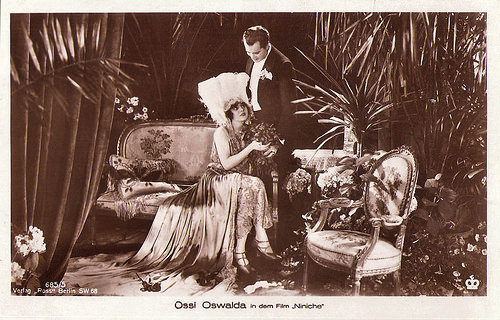
German postcard by Ross Verlag, no. 685/5, 1919-1924. Photo: Westi Film. Publicity still for Niniche (Victor Janson, 1925) with Ossi Oswalda .
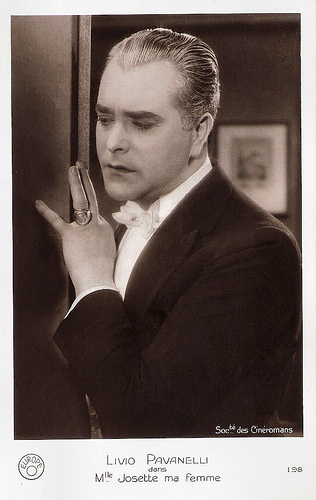
French postcard by Europe, no. 198. Photo: Société des Cinéromans. Livio Pavanelli in Fräulein Josette - meine Frau (Gaston Ravel, 1926), starring Dolly Davis and Pavanelli. Its French release title was Mademoiselle Josette ma femme. It was based on a play by Robert Charvay.
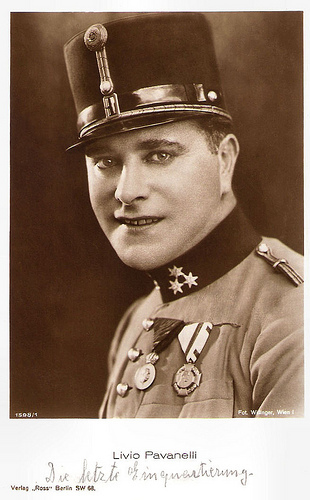
German postcard by Ross Verlag, no. 1598/1,1927-1928 . Photo Willinger, Vienna. Livio Pavanelli in the German silent film Die letzte Einquartierung aka Küssen ist keine Sünd' (Rudolf Walther-Fein, Rudolf Dworsky, 1926), starring Xenia Desni.
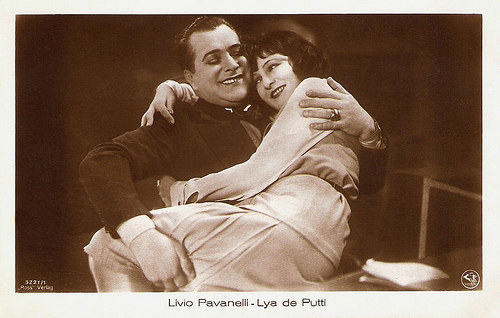
German postcard by Ross Verlag, no. 3221/1, 1928-1929. Photo: Phoebus-Film AG. Livio Pavanelli and Lya de Putti in the German silent film Charlott ertwas verrückt/Charlott a little crazy (Adolf E. Licho, 1929).
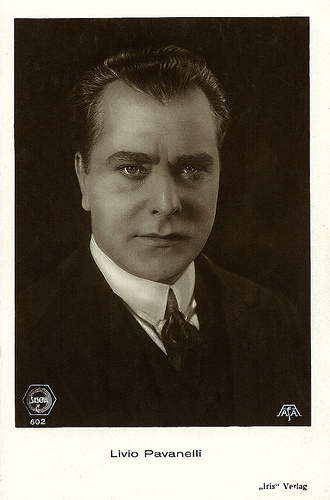
Austrian postcard by Iris Verlag, no. 602. Photo: Aafa Film / Sascha Film.
Producer, Scriptwriter and Director
When sound cinema was there to stay, Livio Pavanelli returned to Italy. He first played opposite former silent star Maria Jacobini in the film Perché no?/Why Not? (Amleto Palermi, 1930), an Italian language version of The Lady Lies (Hobart Henley, 1929), shot in the Paramount studios in Paris. Pavanelli next had a part in the German sound film Liebeskommando/Love's Command (Geza von Bolvary, 1931) with Dolly Haas .
Then he returned to Italy, where he acted in films like Pergolesi (Guido Brignone, 1932) with Elio Steiner in the title role, and L’ultimo dei Bergerac/The last of the Bergeracs (Gennaro Righelli, 1933). However, his star had declined. Pavanelli had one last film performance in Germany in the film Frühlingsmärchen/Spring Fairy Tale (Carl Froehlich, 1934), in which he appropriately played a singing master from Milan.
According to Wikipedia Pavanelli played both in the Italian and the German version of Max Neufeld’s La canzone del sole/Das Lied der Sonne/The Song of the Sun (1934), starring Vittorio De Sica . He also performed in Gustav Machaty’s Italian production Ballerine/Ballerinas (1936).
In the 1930s Pavanelli also became producer, scriptwriter and director. Wikipedia claims that one of his productions was opera singer Tito Schipa’s success film Vivere/To Live (Guido Brignone, 1937), while IMDb lists Pavanelli not as producer but as production manager or unit manager for 10 different films between 1939 and 1954. He often worked thus for director Guido Brignone such as La mia canzone al vento (Guido Brignone, 1939) and Romanzo di un giovane povero/The novel of a poor young man (Guido Brignone, 1942), but also for the postwar epic Messalina/The Affairs of Messalina (Carmine Gallone, 1951). In 1939 Pavanelli was also scriptwriter for La mia canzone al vento/My Song to the Wind.
In 1941 he directed his sole sound feature Solitudine/Loneliness, starring Carola Höhn . In the silent era, Pavanelli had already directed three films: Silvio Pellico (1915), La complice muta/The Mute Accomplice (1920), and Madonnina (1921). Livio Pavanelli’s last film as an actor was L’altra/The Other (Carlo Ludovico Bragaglia, 1947), in which he played a French impresario. After that he continued to work only as production or unit manager. His last job was production management of the epic Cortigiana di Babilonia/The Queen of Babylon (Carlo Ludovico Bragaglia, 1954), starring Rhonda Fleming. Livio Pavanelli died at the hospital San Giovanni in Rome in 1958. He was 76.
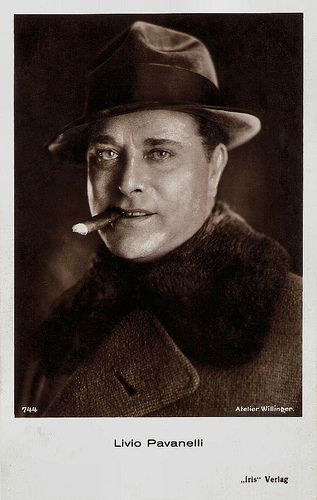
Austrian postcard by Iris Verlag, no. 744. Photo: Atelier Willinger.
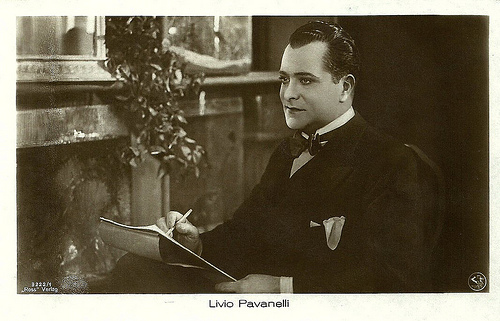
German postcard by Ross Verlag, no. 3222/1, 1928-1929.
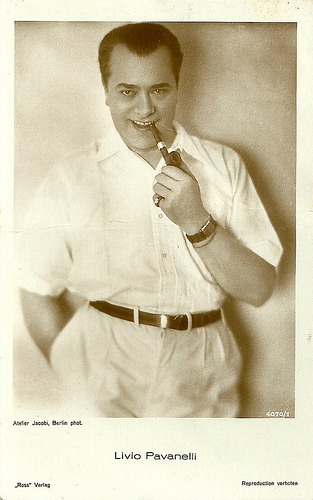
German postcard by Ross Verlag, no. 4070/1, 1929-1930. Photo: Atelier Jacobi, Berlin.
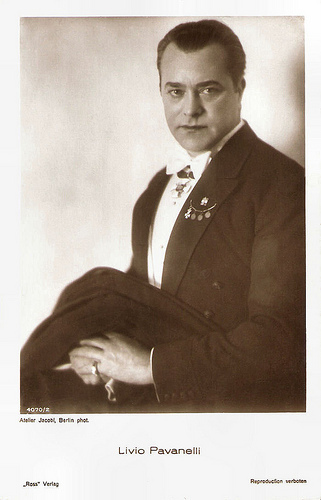
German postcard by Ross Verlag, no. 4070/2, 1929-1930. Photo: Atelier Jacobi, Berlin.
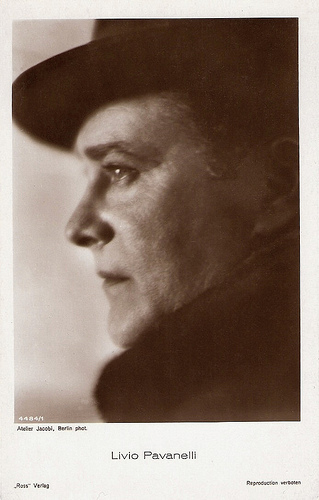
German postcard by Ross Verlag, no. 4484/1, 1929-1930. Photo: Atelier Jacobi, Berlin.
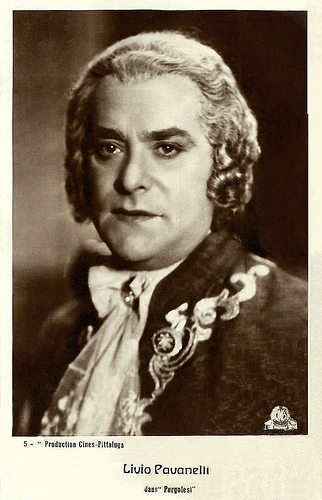
Italian postcard by G.B. Falci, Milano, no. 5. Livio Pavanelli as Nicola d'Arcangeli in Pergolesi (Guido Brignone, 1932).
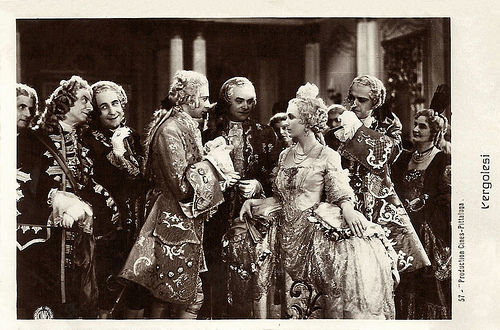
Italian postcard by G.B. Falci, Milano, no. 57. Photo: Cines-Pittaluga. Livio Pavanelli, Carlo Lombardi and Dria Paola in Pergolesi (Guido Brignone, 1932). Bystanders gossip while Nicola d'Arcangeli (Livio Pavanelli) introduces his sister Maria ( Dria Paola ) to the man he has selected for her, the aristocrat Raniero di Tor Delfina (Carlo Lombardi). She is in love with Pergolesi (Elio Steiner), though, whom the brother considers too low in class.
Sources: Thomas Staedeli (Cyranos), Filmportal.de, Wikipedia (Italian), and .

Italian postcard by La Rotofotografia, no. 83. Photo: Rinoscimento Film.

Austrian photo by Willinger, Wien. From Tatiana. Xenia Desni and Livio Pavanelli in the German silent film Die letzte Einquartierung aka Küssen ist keine Sünd'/Kissing is no sin (Rudolf Walther-Fein, Rudolf Dworsky, 1926).

Austrian postcard by Iris Verlag, no. 5154. Photo: Aafa / Lux Film Verleih.

Austrian postcard by Iris Verlag, no. 5311. Photo: Aafa Film / Lux-Film-Verleih.

German postcard by Ross Verlag, no. 1769/2, 1927-1928. Photo: Atelier Willinger, Wien (Vienna).
Divas
Livio Cesare Pavanelli was born in Copparo, Italy in 1881. He was member of a big family of farmers and merchants from the Ferrara area. His father Andrea was also a notable patriot in the Italian Risorgimento. As a consequence of financial disasters in the family he moved with his parents to Bologna where he visited the technical school. During his adolescence he wandered around Italy, eager for excitement. When in Venice in 1898, he fell in love with the stage while assisting a show of wandering artists. He performed with various companies like that of Antonio Gandusio, and in 1902 the Venetian company of Emilio Zago. He then shifted to the company of Gustavo Salvini and Ermete Zacconi , before reaching Eleonora Duse ’s company with whom he stayed for 9 years, accompanying her at her foreign tours as well.
In the early 1910s he performed leads in various films, starting in a series of short silent films with Pina Fabbri including Il delitto della via di Nizza (Henri Etievant, 1913) and Il romanzo di due vite/The novel of two lives (Attilio Fabbri, 1913). From 1914 on he starred in a series of films with Hesperia like L’ereditiera/The heiress (Baldassarre Negroni, 1914) and L’agguato/The trap (Guglielmo Zorzi, 1915); with Mercedes Brignone like Il re dell’Atlantico/The king of the Atlantic (Baldassarre Negroni, 1914) and Mezzanotte/Midnight (Augusto Genina, 1915); and with Gianna Terribili-Gonzales.
In 1916-1917 Pavanelli didn’t appear in a film, but in 1918 he was back in business. He starred opposite Francesca Bertini in various parts of the series I sette peccati capitali/The seven capital sins (Camillo De Riso a.o., 1918), La piovra/The Octopus (Edoardo Bencivenga, 1919) and Anima allegra/Happy soul (Roberto Roberti, 1919). He also appeared opposite another diva, Lyda Borelli , in Carnevalesca/Carnival (Amleto Palermi, 1918) and Una notte a Calcutta/A Night in Calcutta (Mario Caserini, 1918). In 1918 he also played Saint Sebastian in Enrico Guazzoni’s epic Fabiola (1918), with Elena Sangro in the title role, and he had a part in the propagandist fake biopic of Francesca Bertini : Mariute (Edoardo Bencivenga, 1918), starring the diva herself.
In those years, Thea Pavanelli aka Thea played with Pavanelli in La reginetta Isotta/The queen Isotta (1918), based on a story by Honoré de Balzac. Reportedly she was his wife, but no additional information is available about this. In the following years, Pavanelli became a superstar of the Italian silent cinema. He was the star of epic films like Il sacco di Roma/The Sack of Rome (Enrico Guazzoni, Giulio Aristide Sartorio, 1920), but he also appeared in a long list of diva films with Pina Menichelli such as La storia di una donna/A Woman's Story (Eugenio Perego, 1920), La verità nuda/Woman Against Woman (Telemaco Ruggeri, 1921), L’età critica/The critical age (Amleto Palermi, 1921), La seconda moglie/The second wife (Amleto Palermi, 1922), and La biondina/The Blonde (Amleto Palermi, 1923).
Other actresses opposite whom Pavanelli acted in the early 1920s were Tilde Kassay, Diomira Jacobini , and Cecyl Tryan . In Saitra la ribelle/Saitra the rebel (Amleto Palermi, 1924), Coiffeur pour dames/Ladies' hairdresser (Amleto Palermi, 1924) and Vedi Napoli, poi muori/You see Naples and then you die (Eugenio Perego, 1924), Pavanelli played opposite Leda Gys . He also played the lead of Turiddu opposite Tina Xeo as Santuzza in the adaptation of Giovanni Verga’s story and Pietro Mascagni’s opera Cavalleria rusticana/Rustic Chivalry (Mario Gargiulo, 1924).

Italian postcard. by Ed. A. Traldi, Milano, no. 5. Photo: Pinto, Roma.

Italian postcard by Ed. G.B. Falci, Milano, no. 262. Pina Menichelli and Livio Pavanelli in La seconda moglie (Amleto Palermi, 1922).

Italian postcard by Ed. G.B. Falci, Milano. Pina Menichelli , Livio Pavanelli and Orietta Claudi in the Italian silent film La seconda moglie (Amleto Palermi, 1922).

Italian postcard, No. 67?. Photo: Aafa Film. Perhaps for the film German silent film Die letzte Einquartierung aka Küssen ist keine Sünd'/Kissing is no sin (Rudolf Walther-Fein, Rudolf Dworsky, 1926) with Livio Pavanelli and Xenia Desni .

German postcard by Verlag Hermann Leiser, Berlin-Wilm., no 6126. Photo: T. De Virgiliis.
Weimar Cinema
In 1924, there was a serious crisis in the Italian cinema. Livio Pavanelli moved to Austria first and then to Germany, where he could continue his successful career. He performed opposite many female stars of the Weimar cinema, such as Lee Parry in Die schönste Frau der Welt/The Most Beautiful Woman of the World (Richard Eichberg, 1924), Fern Andra in Die Liebe is der Frauen Macht/Love is the Women's Power (Erich Engel, Georg Bluen, 1924), Liane Haid in Ich liebe dich!/I Love You (Paul L. Stein, 1924), Im weissen Rössl/The White Horse Inn (Richard Oswald, 1926), and Als ich wieder kam (1926); and Ossi Oswalda in Niniche (1924).
Other films were Der Ritt in die Sonne/The ride in the sun (Georg Jacoby, 1926), Das Gasthaus zur Ehe/The Marriage Guesthouse (Georg Jacoby, 1926), and Mein Freund der Chauffeur/My Friend the Chauffeur (Erich Waschneck, 1926) with Hans Albers . In 1926 Pavanelli played in various boulevard comedies: he had the male lead as the industrial Franz Kaltenbach in Familie Schimeck/Wiener Herzen/The Schimeck Family (Alfred Halm, Rudolf Dworsky, 1926) opposite Olga Tschechova , and also the male lead in Der lachende Ehemann/The Laughing Husband (Rudolf Walther-Fein, Rudolf Dworsky, 1926) with Elisabeth Pinajeff as his wife.
1926 was Pavanelli’s most prolific year. The next year, films with Mary Nolan , Mady Christians and Xenia Desni followed, but also parts in the Henny Porten drama Die grosse Pause/The big break (Carl Froehlich, 1927). He returned temporarily to Italy to play Florette in the adaptation of the popular boulevard comedy Florette e Patapon/Florette and Patapon (Amleto Palermi, 1927), with French actor Marcel Lévesque as Patapon.
In 1928 followed parts in the Lya de Putti comedy Charlott etwas verrückt/Charlott a bit crazy (Adolf E. Licho, 1928), the Spanish-German production Herzen ohne Ziel/Corazones sin rumbo/Hearts Without Soul (Benito Perojo, Gustav Ucicky, 1928), the Italo-German coproduction Scampolo (Augusto Genina, 1928), and the Ossi Oswalda vehicle Das Haus ohne Männer/The House Without Men (Rolf Randolf, 1928).
Pavanelli played the lead in Liebfraumilch (Carl Froehlich, 1929) and Sir Henry Baskerville in Der Hund von Baskerville/The Hound of the Baskervilles (Richard Oswald, 1929). Even in 1930 Pavanelli continued to play in German films, such as Freiheit in Fesseln/Freedom in chains (Carl Heinz Wolff, 1930), starring Fritz Kampers and Vivian Gibson , and Ehestreik/Marriage strike (Carl Boese, 1930), with Georg Alexander and Maria Paudler .

German postcard by Ross Verlag, no. 685/5, 1919-1924. Photo: Westi Film. Publicity still for Niniche (Victor Janson, 1925) with Ossi Oswalda .

French postcard by Europe, no. 198. Photo: Société des Cinéromans. Livio Pavanelli in Fräulein Josette - meine Frau (Gaston Ravel, 1926), starring Dolly Davis and Pavanelli. Its French release title was Mademoiselle Josette ma femme. It was based on a play by Robert Charvay.

German postcard by Ross Verlag, no. 1598/1,1927-1928 . Photo Willinger, Vienna. Livio Pavanelli in the German silent film Die letzte Einquartierung aka Küssen ist keine Sünd' (Rudolf Walther-Fein, Rudolf Dworsky, 1926), starring Xenia Desni.

German postcard by Ross Verlag, no. 3221/1, 1928-1929. Photo: Phoebus-Film AG. Livio Pavanelli and Lya de Putti in the German silent film Charlott ertwas verrückt/Charlott a little crazy (Adolf E. Licho, 1929).

Austrian postcard by Iris Verlag, no. 602. Photo: Aafa Film / Sascha Film.
Producer, Scriptwriter and Director
When sound cinema was there to stay, Livio Pavanelli returned to Italy. He first played opposite former silent star Maria Jacobini in the film Perché no?/Why Not? (Amleto Palermi, 1930), an Italian language version of The Lady Lies (Hobart Henley, 1929), shot in the Paramount studios in Paris. Pavanelli next had a part in the German sound film Liebeskommando/Love's Command (Geza von Bolvary, 1931) with Dolly Haas .
Then he returned to Italy, where he acted in films like Pergolesi (Guido Brignone, 1932) with Elio Steiner in the title role, and L’ultimo dei Bergerac/The last of the Bergeracs (Gennaro Righelli, 1933). However, his star had declined. Pavanelli had one last film performance in Germany in the film Frühlingsmärchen/Spring Fairy Tale (Carl Froehlich, 1934), in which he appropriately played a singing master from Milan.
According to Wikipedia Pavanelli played both in the Italian and the German version of Max Neufeld’s La canzone del sole/Das Lied der Sonne/The Song of the Sun (1934), starring Vittorio De Sica . He also performed in Gustav Machaty’s Italian production Ballerine/Ballerinas (1936).
In the 1930s Pavanelli also became producer, scriptwriter and director. Wikipedia claims that one of his productions was opera singer Tito Schipa’s success film Vivere/To Live (Guido Brignone, 1937), while IMDb lists Pavanelli not as producer but as production manager or unit manager for 10 different films between 1939 and 1954. He often worked thus for director Guido Brignone such as La mia canzone al vento (Guido Brignone, 1939) and Romanzo di un giovane povero/The novel of a poor young man (Guido Brignone, 1942), but also for the postwar epic Messalina/The Affairs of Messalina (Carmine Gallone, 1951). In 1939 Pavanelli was also scriptwriter for La mia canzone al vento/My Song to the Wind.
In 1941 he directed his sole sound feature Solitudine/Loneliness, starring Carola Höhn . In the silent era, Pavanelli had already directed three films: Silvio Pellico (1915), La complice muta/The Mute Accomplice (1920), and Madonnina (1921). Livio Pavanelli’s last film as an actor was L’altra/The Other (Carlo Ludovico Bragaglia, 1947), in which he played a French impresario. After that he continued to work only as production or unit manager. His last job was production management of the epic Cortigiana di Babilonia/The Queen of Babylon (Carlo Ludovico Bragaglia, 1954), starring Rhonda Fleming. Livio Pavanelli died at the hospital San Giovanni in Rome in 1958. He was 76.

Austrian postcard by Iris Verlag, no. 744. Photo: Atelier Willinger.

German postcard by Ross Verlag, no. 3222/1, 1928-1929.

German postcard by Ross Verlag, no. 4070/1, 1929-1930. Photo: Atelier Jacobi, Berlin.

German postcard by Ross Verlag, no. 4070/2, 1929-1930. Photo: Atelier Jacobi, Berlin.

German postcard by Ross Verlag, no. 4484/1, 1929-1930. Photo: Atelier Jacobi, Berlin.

Italian postcard by G.B. Falci, Milano, no. 5. Livio Pavanelli as Nicola d'Arcangeli in Pergolesi (Guido Brignone, 1932).

Italian postcard by G.B. Falci, Milano, no. 57. Photo: Cines-Pittaluga. Livio Pavanelli, Carlo Lombardi and Dria Paola in Pergolesi (Guido Brignone, 1932). Bystanders gossip while Nicola d'Arcangeli (Livio Pavanelli) introduces his sister Maria ( Dria Paola ) to the man he has selected for her, the aristocrat Raniero di Tor Delfina (Carlo Lombardi). She is in love with Pergolesi (Elio Steiner), though, whom the brother considers too low in class.
Sources: Thomas Staedeli (Cyranos), Filmportal.de, Wikipedia (Italian), and .
Published on May 23, 2016 22:00
Paul van Yperen's Blog
- Paul van Yperen's profile
- 13 followers
Paul van Yperen isn't a Goodreads Author
(yet),
but they
do have a blog,
so here are some recent posts imported from
their feed.



